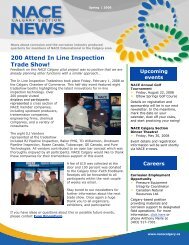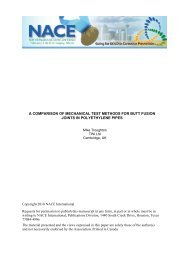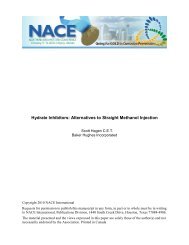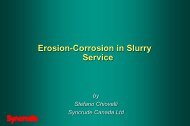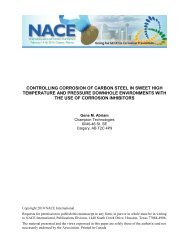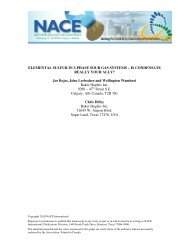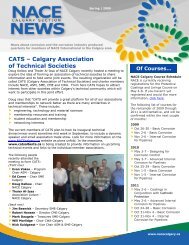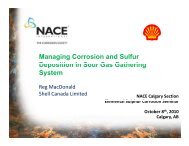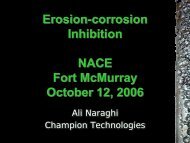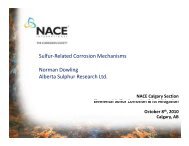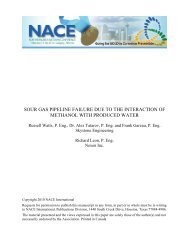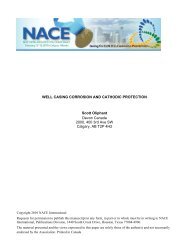the influence of insulation materials on corrosion ... - NACE Calgary
the influence of insulation materials on corrosion ... - NACE Calgary
the influence of insulation materials on corrosion ... - NACE Calgary
Create successful ePaper yourself
Turn your PDF publications into a flip-book with our unique Google optimized e-Paper software.
THE INFLUENCE OF INSULATION MATERIALS ON<br />
CORROSION UNDER INSULATION<br />
John Williams<br />
Aspen Aerogels, Inc.<br />
30 Forbes Rd., Bldg B<br />
Northborough, MA 01532<br />
Owen Evans<br />
Aspen Aerogels, Inc.<br />
30 Forbes Rd., Bldg B<br />
Northborough, MA 01532<br />
Copyright 2010 <strong>NACE</strong> Internati<strong>on</strong>al<br />
Requests for permissi<strong>on</strong> to publish this manuscript in any form, in part or in whole must be in writing<br />
to <strong>NACE</strong> Internati<strong>on</strong>al, Publicati<strong>on</strong>s Divisi<strong>on</strong>, 1440 South Creek Drive, Houst<strong>on</strong>, Texas 77084-4906.<br />
The material presented and <str<strong>on</strong>g>the</str<strong>on</strong>g> views expressed in this paper are solely those <str<strong>on</strong>g>of</str<strong>on</strong>g> <str<strong>on</strong>g>the</str<strong>on</strong>g> author(s) and not<br />
necessarily endorsed by <str<strong>on</strong>g>the</str<strong>on</strong>g> Associati<strong>on</strong>. Printed in Canada
ABSTRACT<br />
The designer <str<strong>on</strong>g>of</str<strong>on</strong>g> industrial equipment and piping has three weap<strong>on</strong>s in <str<strong>on</strong>g>the</str<strong>on</strong>g> fight against corrosi<strong>on</strong><br />
under <str<strong>on</strong>g>insulati<strong>on</strong></str<strong>on</strong>g> (CUI). The first and primary defense against CUI is a high quality, immersi<strong>on</strong><br />
grade coating. The sec<strong>on</strong>d is a properly designed and installed wea<str<strong>on</strong>g>the</str<strong>on</strong>g>r barrier jacketing. The<br />
third and, arguably, least understood element is <str<strong>on</strong>g>the</str<strong>on</strong>g> choice <str<strong>on</strong>g>of</str<strong>on</strong>g> <str<strong>on</strong>g>insulati<strong>on</strong></str<strong>on</strong>g> material. This paper will<br />
explore <str<strong>on</strong>g>the</str<strong>on</strong>g> ways in which <str<strong>on</strong>g>insulati<strong>on</strong></str<strong>on</strong>g> <str<strong>on</strong>g>materials</str<strong>on</strong>g> <str<strong>on</strong>g>influence</str<strong>on</strong>g> CUI behavior, presenting results from<br />
both laboratory- and field-testing <strong>on</strong> seven industrial <str<strong>on</strong>g>insulati<strong>on</strong></str<strong>on</strong>g> <str<strong>on</strong>g>materials</str<strong>on</strong>g> and <strong>on</strong>e composite system.<br />
The <str<strong>on</strong>g>materials</str<strong>on</strong>g> tested were calcium silicate, expanded perlite, cellular glass, mineral wool<br />
(both regular and water-repellent grade), and two types <str<strong>on</strong>g>of</str<strong>on</strong>g> flexible aerogel blanket material, Pyrogel<br />
XT and Cryogel Z.<br />
Keywords: Insulati<strong>on</strong>, corrosi<strong>on</strong>, CUI, aerogel, mineral wool, calcium silicate, expanded perlite,<br />
cellular glass, wetting
INTRODUCTION<br />
The designer <str<strong>on</strong>g>of</str<strong>on</strong>g> industrial <str<strong>on</strong>g>insulati<strong>on</strong></str<strong>on</strong>g> systems has three main weap<strong>on</strong>s in <str<strong>on</strong>g>the</str<strong>on</strong>g> fight against corrosi<strong>on</strong><br />
under <str<strong>on</strong>g>insulati<strong>on</strong></str<strong>on</strong>g> (CUI). The first and primary defense against CUI is a high quality, immersi<strong>on</strong>-grade<br />
coating. The sec<strong>on</strong>d is a properly designed and installed wea<str<strong>on</strong>g>the</str<strong>on</strong>g>r barrier jacketing<br />
and, if operating below <str<strong>on</strong>g>the</str<strong>on</strong>g> atmospheric dew point, vapor barrier. The third and, arguably, least<br />
understood element is <str<strong>on</strong>g>the</str<strong>on</strong>g> choice <str<strong>on</strong>g>of</str<strong>on</strong>g> <str<strong>on</strong>g>insulati<strong>on</strong></str<strong>on</strong>g> material. Historically, hot <str<strong>on</strong>g>insulati<strong>on</strong></str<strong>on</strong>g> products<br />
have been divided into categories <str<strong>on</strong>g>of</str<strong>on</strong>g> wetting and n<strong>on</strong>-wetting, or “hydrophobic” <str<strong>on</strong>g>materials</str<strong>on</strong>g>. The<br />
distincti<strong>on</strong> is important because, as pointed out in <strong>NACE</strong> Standard RP0198-98:<br />
“Because CUI is a product <str<strong>on</strong>g>of</str<strong>on</strong>g> wet metal exposure durati<strong>on</strong>, <str<strong>on</strong>g>the</str<strong>on</strong>g> <str<strong>on</strong>g>insulati<strong>on</strong></str<strong>on</strong>g> system that holds<br />
<str<strong>on</strong>g>the</str<strong>on</strong>g> least amount <str<strong>on</strong>g>of</str<strong>on</strong>g> water and dries most quickly should result in <str<strong>on</strong>g>the</str<strong>on</strong>g> least amount <str<strong>on</strong>g>of</str<strong>on</strong>g> corrosi<strong>on</strong><br />
damage to equipment.” 1<br />
A more recent European m<strong>on</strong>ograph states flatly:<br />
“Insulati<strong>on</strong> that minimizes water ingress and does not retain water can effectively act as a<br />
barrier to CUI.” 2<br />
Never<str<strong>on</strong>g>the</str<strong>on</strong>g>less, though many engineers do prescribe <str<strong>on</strong>g>the</str<strong>on</strong>g> use <str<strong>on</strong>g>of</str<strong>on</strong>g> water-repellent <str<strong>on</strong>g>materials</str<strong>on</strong>g> <strong>on</strong> equipment<br />
operating in <str<strong>on</strong>g>the</str<strong>on</strong>g> CUI range (-4 to 175°C, or 25-347°F), <str<strong>on</strong>g>the</str<strong>on</strong>g> practice is far from universal.<br />
Some <str<strong>on</strong>g>of</str<strong>on</strong>g> <str<strong>on</strong>g>the</str<strong>on</strong>g> reluctance undoubtedly stems from cost sensitivity, since water-repellent <str<strong>on</strong>g>insulati<strong>on</strong></str<strong>on</strong>g><br />
<str<strong>on</strong>g>materials</str<strong>on</strong>g> are generally more expensive than <str<strong>on</strong>g>the</str<strong>on</strong>g>ir water-absorbent cousins. Such sensitivity is<br />
<str<strong>on</strong>g>of</str<strong>on</strong>g>ten misplaced, as <str<strong>on</strong>g>the</str<strong>on</strong>g> cost, hazard, and disrupti<strong>on</strong> <str<strong>on</strong>g>of</str<strong>on</strong>g> even <strong>on</strong>e corrosi<strong>on</strong> event can far outweigh<br />
any savings – real or perceived – <strong>on</strong> <str<strong>on</strong>g>insulati<strong>on</strong></str<strong>on</strong>g> <str<strong>on</strong>g>materials</str<strong>on</strong>g>.<br />
Ano<str<strong>on</strong>g>the</str<strong>on</strong>g>r barrier to <str<strong>on</strong>g>the</str<strong>on</strong>g> effective use <str<strong>on</strong>g>of</str<strong>on</strong>g> water-repellent <str<strong>on</strong>g>materials</str<strong>on</strong>g> is simply <str<strong>on</strong>g>the</str<strong>on</strong>g> general lack <str<strong>on</strong>g>of</str<strong>on</strong>g><br />
comparative material data for different <str<strong>on</strong>g>insulati<strong>on</strong></str<strong>on</strong>g> products. Although previous authors have addressed<br />
<str<strong>on</strong>g>the</str<strong>on</strong>g> pros and c<strong>on</strong>s <str<strong>on</strong>g>of</str<strong>on</strong>g> various <str<strong>on</strong>g>insulati<strong>on</strong></str<strong>on</strong>g> <str<strong>on</strong>g>materials</str<strong>on</strong>g> (e.g., Refs. 3 and 4), <str<strong>on</strong>g>the</str<strong>on</strong>g> approach has<br />
typically been <strong>on</strong>e <str<strong>on</strong>g>of</str<strong>on</strong>g> cataloging CUI outcomes within operating facilities. While those insights<br />
are invaluable, <str<strong>on</strong>g>the</str<strong>on</strong>g>y d<strong>on</strong>’t allow <str<strong>on</strong>g>the</str<strong>on</strong>g> isolati<strong>on</strong> <str<strong>on</strong>g>of</str<strong>on</strong>g> specific variables or mechanisms – <str<strong>on</strong>g>of</str<strong>on</strong>g> which<br />
<str<strong>on</strong>g>the</str<strong>on</strong>g>re are many 5 – because <str<strong>on</strong>g>the</str<strong>on</strong>g>y are basically unc<strong>on</strong>trolled experiments.<br />
To address this gap in <str<strong>on</strong>g>the</str<strong>on</strong>g> literature, <str<strong>on</strong>g>the</str<strong>on</strong>g> authors spent over a year doing laboratory testing <strong>on</strong><br />
some <str<strong>on</strong>g>of</str<strong>on</strong>g> <str<strong>on</strong>g>the</str<strong>on</strong>g> most comm<strong>on</strong> hot <str<strong>on</strong>g>insulati<strong>on</strong></str<strong>on</strong>g> <str<strong>on</strong>g>materials</str<strong>on</strong>g>, including:<br />
• Calcium silicate<br />
• Expanded perlite (two different brands)<br />
• Cellular glass<br />
• Mineral wool, including both regular and water-repellent grade (WRG)<br />
• Two types <str<strong>on</strong>g>of</str<strong>on</strong>g> flexible aerogel blanket material, Pyrogel XT and Cryogel Z.<br />
As described in <str<strong>on</strong>g>the</str<strong>on</strong>g> secti<strong>on</strong>s below, <str<strong>on</strong>g>the</str<strong>on</strong>g> four sets <str<strong>on</strong>g>of</str<strong>on</strong>g> laboratory tests focused <strong>on</strong>: 1) <str<strong>on</strong>g>the</str<strong>on</strong>g> effectiveness<br />
<str<strong>on</strong>g>of</str<strong>on</strong>g> various corrosi<strong>on</strong> inhibitors, 2) hydrophobe durability, 3) maximum water uptake, and 4)<br />
dry-out kinetics. In additi<strong>on</strong>, each <str<strong>on</strong>g>of</str<strong>on</strong>g> <str<strong>on</strong>g>the</str<strong>on</strong>g>se <str<strong>on</strong>g>materials</str<strong>on</strong>g> was subjected to 12 weeks <str<strong>on</strong>g>of</str<strong>on</strong>g> outdoor exposure<br />
<strong>on</strong> a bare-steel test rig to provide a more “real world” perspective. The results have been<br />
distilled into a set <str<strong>on</strong>g>of</str<strong>on</strong>g> rankings, provided in <str<strong>on</strong>g>the</str<strong>on</strong>g> C<strong>on</strong>clusi<strong>on</strong>s secti<strong>on</strong>.
THE ROLE OF INSULATION IN CUI<br />
Insulati<strong>on</strong> <str<strong>on</strong>g>materials</str<strong>on</strong>g> c<strong>on</strong>tribute to CUI in <str<strong>on</strong>g>the</str<strong>on</strong>g> following three ways:<br />
1. Providing an annular space which can collect water and o<str<strong>on</strong>g>the</str<strong>on</strong>g>r corrosive media<br />
2. Leaching out c<strong>on</strong>taminants that accelerate <str<strong>on</strong>g>the</str<strong>on</strong>g> corrosi<strong>on</strong> process, and<br />
3. Wicking and/or absorbing water and holding it against <str<strong>on</strong>g>the</str<strong>on</strong>g> substrate. 1<br />
Item 1 is less a questi<strong>on</strong> <str<strong>on</strong>g>of</str<strong>on</strong>g> material compositi<strong>on</strong> than <str<strong>on</strong>g>of</str<strong>on</strong>g> form factor. An annular gap is inherent<br />
to pipe cover, as <str<strong>on</strong>g>the</str<strong>on</strong>g> inside diameter must be oversized to accommodate <str<strong>on</strong>g>the</str<strong>on</strong>g> worst-case tolerance<br />
stack-up <str<strong>on</strong>g>of</str<strong>on</strong>g> both <str<strong>on</strong>g>the</str<strong>on</strong>g> pipe and <str<strong>on</strong>g>the</str<strong>on</strong>g> <str<strong>on</strong>g>insulati<strong>on</strong></str<strong>on</strong>g>. 6 Flexible blanket <str<strong>on</strong>g>materials</str<strong>on</strong>g>, spray-applied products<br />
and, to a lesser extent, V-grooved board are more c<strong>on</strong>formal to <str<strong>on</strong>g>the</str<strong>on</strong>g> substrate and so provide less<br />
space for water retenti<strong>on</strong> between <str<strong>on</strong>g>the</str<strong>on</strong>g> <str<strong>on</strong>g>insulati<strong>on</strong></str<strong>on</strong>g> and <str<strong>on</strong>g>the</str<strong>on</strong>g> surface <str<strong>on</strong>g>of</str<strong>on</strong>g> <str<strong>on</strong>g>the</str<strong>on</strong>g> piping or equipment. All<br />
else being equal, c<strong>on</strong>formal <str<strong>on</strong>g>insulati<strong>on</strong></str<strong>on</strong>g> products will be less pr<strong>on</strong>e to CUI than pipe cover.<br />
The leaching <str<strong>on</strong>g>of</str<strong>on</strong>g> c<strong>on</strong>taminants is a material issue, and has received c<strong>on</strong>siderable attenti<strong>on</strong>. ASTM,<br />
for example, has in place a suite <str<strong>on</strong>g>of</str<strong>on</strong>g> test protocols (C692, 7 C871 8 ) and acceptance standards<br />
(C795 9 ) that describe <str<strong>on</strong>g>the</str<strong>on</strong>g> requirements around c<strong>on</strong>taminant leaching, particularly as it c<strong>on</strong>cerns<br />
stress corrosi<strong>on</strong> cracking <str<strong>on</strong>g>of</str<strong>on</strong>g> austenitic stainless steels. Because several <str<strong>on</strong>g>of</str<strong>on</strong>g> <str<strong>on</strong>g>the</str<strong>on</strong>g> <str<strong>on</strong>g>materials</str<strong>on</strong>g> used in<br />
this study use corrosi<strong>on</strong> inhibitors in <str<strong>on</strong>g>the</str<strong>on</strong>g>ir manufacture, an experimental assessment has been<br />
made as to <str<strong>on</strong>g>the</str<strong>on</strong>g> l<strong>on</strong>g-term efficacy <str<strong>on</strong>g>of</str<strong>on</strong>g> those inhibitors.<br />
The behavior <str<strong>on</strong>g>of</str<strong>on</strong>g> <str<strong>on</strong>g>insulati<strong>on</strong></str<strong>on</strong>g> <str<strong>on</strong>g>materials</str<strong>on</strong>g> in <str<strong>on</strong>g>the</str<strong>on</strong>g> presence <str<strong>on</strong>g>of</str<strong>on</strong>g> liquid water is a surprisingly complex issue.<br />
For example, while <str<strong>on</strong>g>the</str<strong>on</strong>g> use <str<strong>on</strong>g>of</str<strong>on</strong>g> hydrophobic <str<strong>on</strong>g>materials</str<strong>on</strong>g> should be part <str<strong>on</strong>g>of</str<strong>on</strong>g> any effective CUI<br />
strategy, not all hydrophobing agents are created equal. Testing has been carried out to determine<br />
<str<strong>on</strong>g>the</str<strong>on</strong>g> l<strong>on</strong>g-term <str<strong>on</strong>g>the</str<strong>on</strong>g>rmal stability <str<strong>on</strong>g>of</str<strong>on</strong>g> four different n<strong>on</strong>-wetting <str<strong>on</strong>g>insulati<strong>on</strong></str<strong>on</strong>g> <str<strong>on</strong>g>materials</str<strong>on</strong>g>. In additi<strong>on</strong>,<br />
all <str<strong>on</strong>g>insulati<strong>on</strong></str<strong>on</strong>g> <str<strong>on</strong>g>materials</str<strong>on</strong>g> have different capacities for holding water, as well as different rates<br />
by which <str<strong>on</strong>g>the</str<strong>on</strong>g>y dry-out. This includes even <str<strong>on</strong>g>the</str<strong>on</strong>g> water-repellent <str<strong>on</strong>g>materials</str<strong>on</strong>g>, which can become saturated<br />
when subjected to aggressive c<strong>on</strong>diti<strong>on</strong>s (e.g., prol<strong>on</strong>ged submersi<strong>on</strong>). The greater a material’s<br />
holding capacity and <str<strong>on</strong>g>the</str<strong>on</strong>g> l<strong>on</strong>ger its dry-out period, <str<strong>on</strong>g>the</str<strong>on</strong>g> more risk <str<strong>on</strong>g>the</str<strong>on</strong>g>re is for developing<br />
CUI after a wetting event. Experimental and analytical methods have been used to assess both<br />
<str<strong>on</strong>g>the</str<strong>on</strong>g> maximum water capacity and dry-out kinetics for each <str<strong>on</strong>g>of</str<strong>on</strong>g> <str<strong>on</strong>g>the</str<strong>on</strong>g>se <str<strong>on</strong>g>materials</str<strong>on</strong>g>. These activities<br />
are described below.<br />
EFFECTIVENESS OF CORROSION INHIBITORS<br />
In <str<strong>on</strong>g>the</str<strong>on</strong>g> event that liquid water penetrates an <str<strong>on</strong>g>insulati<strong>on</strong></str<strong>on</strong>g> material, it is important that that material<br />
maintain an aqueous chemistry within a specific pH range. Insulati<strong>on</strong> <str<strong>on</strong>g>materials</str<strong>on</strong>g> with adventitious<br />
chloride ani<strong>on</strong>s and low pH values can significantly accelerate corrosi<strong>on</strong> rates. To determine<br />
<str<strong>on</strong>g>the</str<strong>on</strong>g> quantity <str<strong>on</strong>g>of</str<strong>on</strong>g> extractable ani<strong>on</strong>s, <str<strong>on</strong>g>materials</str<strong>on</strong>g> are typically tested according to ASTM C871. 8<br />
Regi<strong>on</strong>s <str<strong>on</strong>g>of</str<strong>on</strong>g> unacceptable and acceptable ani<strong>on</strong> quantities are described by <str<strong>on</strong>g>the</str<strong>on</strong>g> Karnes curve,<br />
shown in Figure 1. 9 As part <str<strong>on</strong>g>of</str<strong>on</strong>g> this study, independent, third-party testing has been carried out<br />
<strong>on</strong> calcium silicate, mineral wool, Pyrogel XT, and two different brands <str<strong>on</strong>g>of</str<strong>on</strong>g> expanded perlite.<br />
The results are plotted in Figure 1, which shows that all <str<strong>on</strong>g>the</str<strong>on</strong>g> <str<strong>on</strong>g>materials</str<strong>on</strong>g> tested passed <str<strong>on</strong>g>the</str<strong>on</strong>g> requirements<br />
<str<strong>on</strong>g>of</str<strong>on</strong>g> ASTM C795 for extractable ani<strong>on</strong> quantities.<br />
2
Figure 1: Independently verified extractable ani<strong>on</strong> results according to ASTM C871.<br />
Bey<strong>on</strong>d <str<strong>on</strong>g>the</str<strong>on</strong>g> extractable ani<strong>on</strong> quantities, <str<strong>on</strong>g>the</str<strong>on</strong>g> aqueous pH is ano<str<strong>on</strong>g>the</str<strong>on</strong>g>r critical parameter. The <str<strong>on</strong>g>influence</str<strong>on</strong>g><br />
<str<strong>on</strong>g>of</str<strong>on</strong>g> pH <strong>on</strong> corrosi<strong>on</strong> behavior can be dem<strong>on</strong>strated by <str<strong>on</strong>g>the</str<strong>on</strong>g> simplified Pourbaix diagram <str<strong>on</strong>g>of</str<strong>on</strong>g><br />
Figure 2. These diagrams plot <str<strong>on</strong>g>the</str<strong>on</strong>g> most <str<strong>on</strong>g>the</str<strong>on</strong>g>rmodynamically stable products as a functi<strong>on</strong> <str<strong>on</strong>g>of</str<strong>on</strong>g> pH<br />
and reducti<strong>on</strong> potential. The diagram indicates three distinct regi<strong>on</strong>s <str<strong>on</strong>g>of</str<strong>on</strong>g> interest: 1) immunity, 2)<br />
passivati<strong>on</strong>, and 3) corrosi<strong>on</strong>. The regi<strong>on</strong>s <str<strong>on</strong>g>of</str<strong>on</strong>g> corrosi<strong>on</strong> are associated with <str<strong>on</strong>g>the</str<strong>on</strong>g> oxidati<strong>on</strong> <str<strong>on</strong>g>of</str<strong>on</strong>g> ir<strong>on</strong><br />
metal to soluble Fe +2 or Fe +3 i<strong>on</strong>s, whereas regi<strong>on</strong>s <str<strong>on</strong>g>of</str<strong>on</strong>g> passivati<strong>on</strong> are associated with <str<strong>on</strong>g>the</str<strong>on</strong>g> formati<strong>on</strong><br />
<str<strong>on</strong>g>of</str<strong>on</strong>g> insoluble oxide layers. Likewise, regi<strong>on</strong>s <str<strong>on</strong>g>of</str<strong>on</strong>g> immunity are indicative <str<strong>on</strong>g>of</str<strong>on</strong>g> <str<strong>on</strong>g>the</str<strong>on</strong>g> presence <str<strong>on</strong>g>of</str<strong>on</strong>g><br />
ir<strong>on</strong> metal with no signs <str<strong>on</strong>g>of</str<strong>on</strong>g> chemical reactivity.<br />
Figure 2: Pourbaix diagram <str<strong>on</strong>g>of</str<strong>on</strong>g> an ir<strong>on</strong>-water system at 25°C. 10<br />
3
Also plotted in Figure 2 are two dashed lines (a) and (b). These lines represent <str<strong>on</strong>g>the</str<strong>on</strong>g> EMF potential<br />
for <str<strong>on</strong>g>the</str<strong>on</strong>g> oxidati<strong>on</strong> and reducti<strong>on</strong> <str<strong>on</strong>g>of</str<strong>on</strong>g> water, respectively. The dashed lines thus bracket <str<strong>on</strong>g>the</str<strong>on</strong>g><br />
practical regi<strong>on</strong> <str<strong>on</strong>g>of</str<strong>on</strong>g> stability for an aqueous system, outside <str<strong>on</strong>g>of</str<strong>on</strong>g> which water will begin to decompose.<br />
It is evident from <str<strong>on</strong>g>the</str<strong>on</strong>g> diagram that an aqueous system with a pH value ranging 8 to 13.5<br />
<strong>on</strong>ly exhibits regi<strong>on</strong>s <str<strong>on</strong>g>of</str<strong>on</strong>g> immunity and passivati<strong>on</strong>. In o<str<strong>on</strong>g>the</str<strong>on</strong>g>r words, corrosi<strong>on</strong> will <strong>on</strong>ly occur at<br />
pH values lower than 8, and can become severe for pH < 4.<br />
In order to prevent corrosi<strong>on</strong> <str<strong>on</strong>g>of</str<strong>on</strong>g> carb<strong>on</strong> steel from occurring, <str<strong>on</strong>g>insulati<strong>on</strong></str<strong>on</strong>g> manufacturers will <str<strong>on</strong>g>of</str<strong>on</strong>g>ten<br />
incorporate highly soluble alkaline modifiers to ensure that <str<strong>on</strong>g>the</str<strong>on</strong>g> resulting pH values <str<strong>on</strong>g>of</str<strong>on</strong>g> any absorbed<br />
water are above 8.0. For instance, both calcium silicate and perlite c<strong>on</strong>tain high levels <str<strong>on</strong>g>of</str<strong>on</strong>g><br />
sodium silicate and exhibit extractable pH values <str<strong>on</strong>g>of</str<strong>on</strong>g> ~10.5. Both <str<strong>on</strong>g>of</str<strong>on</strong>g> <str<strong>on</strong>g>the</str<strong>on</strong>g>se <str<strong>on</strong>g>materials</str<strong>on</strong>g> thus exhibit<br />
excellent corrosi<strong>on</strong> performance when tested in <str<strong>on</strong>g>the</str<strong>on</strong>g>ir pristine state, according to ASTM methods<br />
(ASTM C1617, 11 C795, etc). The efficacy <str<strong>on</strong>g>of</str<strong>on</strong>g> sodium silicate as a corrosi<strong>on</strong> inhibitor is derived<br />
mainly from its extraordinarily high solubility in water (> 0.78g/mL), which is comparable to<br />
that <str<strong>on</strong>g>of</str<strong>on</strong>g> table salt. The performance <str<strong>on</strong>g>of</str<strong>on</strong>g> newly manufactured <str<strong>on</strong>g>materials</str<strong>on</strong>g> is, however, not necessarily<br />
a good representati<strong>on</strong> <str<strong>on</strong>g>of</str<strong>on</strong>g> l<strong>on</strong>g-term performance in <str<strong>on</strong>g>the</str<strong>on</strong>g> field if frequent or prol<strong>on</strong>ged exposure to<br />
water is expected. One may surmise that <str<strong>on</strong>g>the</str<strong>on</strong>g> efficacy <str<strong>on</strong>g>of</str<strong>on</strong>g> highly soluble corrosi<strong>on</strong> inhibitors diminishes<br />
up<strong>on</strong> repeated and/or c<strong>on</strong>tinuous water exposure, and that <str<strong>on</strong>g>the</str<strong>on</strong>g> ability <str<strong>on</strong>g>of</str<strong>on</strong>g> <str<strong>on</strong>g>the</str<strong>on</strong>g>se <str<strong>on</strong>g>materials</str<strong>on</strong>g><br />
to resist changes to pH is compromised over time.<br />
Pyrogel XT uses a more durable, magnesium-based corrosi<strong>on</strong> inhibitor with a much lower solubility<br />
in water (0.062g/mL at 25°C). Yet, despite <str<strong>on</strong>g>the</str<strong>on</strong>g> low solubility, it is highly capable <str<strong>on</strong>g>of</str<strong>on</strong>g> maintaining<br />
an aqueous pH value above 8.0, ensuring that <str<strong>on</strong>g>the</str<strong>on</strong>g> <str<strong>on</strong>g>insulati<strong>on</strong></str<strong>on</strong>g> envir<strong>on</strong>ment is c<strong>on</strong>sistently<br />
in a regi<strong>on</strong> <str<strong>on</strong>g>of</str<strong>on</strong>g> stability associated with passivati<strong>on</strong> or immunity (refer to Figure 2).<br />
To understand <str<strong>on</strong>g>the</str<strong>on</strong>g> durability <str<strong>on</strong>g>of</str<strong>on</strong>g> <str<strong>on</strong>g>the</str<strong>on</strong>g> various inhibitors, a series <str<strong>on</strong>g>of</str<strong>on</strong>g> aqueous extracti<strong>on</strong> studies were<br />
carried out. Bulk samples <str<strong>on</strong>g>of</str<strong>on</strong>g> calcium silicate, Pyrogel XT, and two brands <str<strong>on</strong>g>of</str<strong>on</strong>g> perlite were subjected<br />
to c<strong>on</strong>stant flow c<strong>on</strong>diti<strong>on</strong>s using 6 L <str<strong>on</strong>g>of</str<strong>on</strong>g> dei<strong>on</strong>ized water at a variety <str<strong>on</strong>g>of</str<strong>on</strong>g> temperatures. The<br />
chemistry <str<strong>on</strong>g>of</str<strong>on</strong>g> <str<strong>on</strong>g>the</str<strong>on</strong>g> water was sampled hourly and measured for Mg or Na c<strong>on</strong>tent using emissi<strong>on</strong><br />
spectroscopy. The percentage <str<strong>on</strong>g>of</str<strong>on</strong>g> inhibitor extracted was determined by using a gravimetric c<strong>on</strong>versi<strong>on</strong><br />
factor and by knowing <str<strong>on</strong>g>the</str<strong>on</strong>g> total quantity <str<strong>on</strong>g>of</str<strong>on</strong>g> inhibitor present prior to testing. The fracti<strong>on</strong><br />
<str<strong>on</strong>g>of</str<strong>on</strong>g> inhibitor depleti<strong>on</strong> could <str<strong>on</strong>g>the</str<strong>on</strong>g>reby be determined under simulated deluge c<strong>on</strong>diti<strong>on</strong>s.<br />
The results are shown in Figure 3, Figure 4 and Figure 5 as <str<strong>on</strong>g>the</str<strong>on</strong>g> percent <str<strong>on</strong>g>of</str<strong>on</strong>g> corrosi<strong>on</strong> inhibitor remaining<br />
in <str<strong>on</strong>g>the</str<strong>on</strong>g> <str<strong>on</strong>g>insulati<strong>on</strong></str<strong>on</strong>g> over time at 25, 45 and 90°C (77, 113, and 195°F), respectively. Materials<br />
employing sodium silicate lost much or most <str<strong>on</strong>g>of</str<strong>on</strong>g> <str<strong>on</strong>g>the</str<strong>on</strong>g>ir corrosi<strong>on</strong> inhibitor after just 24 hours<br />
exposure. After 48 hours at 90°C, <str<strong>on</strong>g>the</str<strong>on</strong>g> perlite and calcium silicate retained <strong>on</strong>ly 25% and 5% <str<strong>on</strong>g>of</str<strong>on</strong>g><br />
<str<strong>on</strong>g>the</str<strong>on</strong>g>ir inhibitor, respectively, while Pyrogel XT retained 94%.<br />
This testing points to a potential discrepancy between <str<strong>on</strong>g>the</str<strong>on</strong>g> aqueous chemistry <str<strong>on</strong>g>of</str<strong>on</strong>g> pristine <str<strong>on</strong>g>materials</str<strong>on</strong>g><br />
(as <str<strong>on</strong>g>the</str<strong>on</strong>g>y are tested in C692 and C1617) and in-service <str<strong>on</strong>g>materials</str<strong>on</strong>g>, and validates field measurements<br />
reported previously in <str<strong>on</strong>g>the</str<strong>on</strong>g> literature. 12 At a minimum, <strong>on</strong>e can infer that <str<strong>on</strong>g>the</str<strong>on</strong>g> pH values <str<strong>on</strong>g>of</str<strong>on</strong>g><br />
<str<strong>on</strong>g>materials</str<strong>on</strong>g> inhibited with sodium silicate may drift downward over time with c<strong>on</strong>tinuous or repeated<br />
exposure to water, potentially leading to an increase in <str<strong>on</strong>g>the</str<strong>on</strong>g> risk for CUI. In c<strong>on</strong>trast, <str<strong>on</strong>g>the</str<strong>on</strong>g><br />
pH values beneath Pyrogel XT should be more stable over time.<br />
4
Figure 3: Corrosi<strong>on</strong> inhibitor durability at 25°C (77°F).<br />
Figure 4: Corrosi<strong>on</strong> inhibitor durability at 45°C (113°F).<br />
Figure 5: Corrosi<strong>on</strong> inhibitor durability at 90°C (195°F).<br />
5
HYDROPHOBE DURABILITY<br />
Hydrophobicity is <str<strong>on</strong>g>the</str<strong>on</strong>g> tendency <str<strong>on</strong>g>of</str<strong>on</strong>g> a material to repel ra<str<strong>on</strong>g>the</str<strong>on</strong>g>r than absorb liquid water. Of <str<strong>on</strong>g>the</str<strong>on</strong>g> five<br />
water-repellent <str<strong>on</strong>g>materials</str<strong>on</strong>g> included in this study, four (WRG mineral wool, Pyrogel XT, and two<br />
brands <str<strong>on</strong>g>of</str<strong>on</strong>g> expanded perlite) achieve <str<strong>on</strong>g>the</str<strong>on</strong>g>ir water-repellency with chemical additives that make<br />
<str<strong>on</strong>g>the</str<strong>on</strong>g>m resistant – though not impervious – to water’s natural capillary acti<strong>on</strong>. The fifth, cellular<br />
glass, is a closed-cell material that is inherently resistant to liquid water so l<strong>on</strong>g as <str<strong>on</strong>g>the</str<strong>on</strong>g> cell structure<br />
remains intact (i.e., without cracks, punctures, or unsealed joints).<br />
All known hydrophobing agents are organic in nature, and will <str<strong>on</strong>g>the</str<strong>on</strong>g>refore degrade via oxidati<strong>on</strong>.<br />
The rate <str<strong>on</strong>g>of</str<strong>on</strong>g> this degradati<strong>on</strong>, R, depends <strong>on</strong> temperature via <str<strong>on</strong>g>the</str<strong>on</strong>g> Arrhenius relati<strong>on</strong>:<br />
B<br />
R exp ⎜<br />
⎝ T<br />
⎛ ⎞<br />
( T ) = A⋅<br />
⎟<br />
⎠<br />
where T is absolute temperature, and A and B are empirical c<strong>on</strong>stants. In o<str<strong>on</strong>g>the</str<strong>on</strong>g>r words, <str<strong>on</strong>g>the</str<strong>on</strong>g> higher<br />
<str<strong>on</strong>g>the</str<strong>on</strong>g> exposure temperature, <str<strong>on</strong>g>the</str<strong>on</strong>g> shorter <str<strong>on</strong>g>the</str<strong>on</strong>g> lifetime <str<strong>on</strong>g>of</str<strong>on</strong>g> <str<strong>on</strong>g>the</str<strong>on</strong>g> hydrophobe, and <str<strong>on</strong>g>the</str<strong>on</strong>g> greater <str<strong>on</strong>g>the</str<strong>on</strong>g> risk for<br />
CUI.<br />
To better understand <str<strong>on</strong>g>the</str<strong>on</strong>g>se limits, an assessment was made <str<strong>on</strong>g>of</str<strong>on</strong>g> hydrophobe stability at various<br />
temperatures. Sample coup<strong>on</strong>s <str<strong>on</strong>g>of</str<strong>on</strong>g> WRG mineral wool, Pyrogel XT, and two brands <str<strong>on</strong>g>of</str<strong>on</strong>g> expanded<br />
perlite were baked in ovens at temperatures ranging from 300 to 430°C (572 to 806°F) for up to<br />
385 days. Periodically, <str<strong>on</strong>g>the</str<strong>on</strong>g> coup<strong>on</strong>s were removed, cooled to ambient temperature, tested for<br />
water uptake, and <str<strong>on</strong>g>the</str<strong>on</strong>g>n returned to <str<strong>on</strong>g>the</str<strong>on</strong>g> oven. Water uptake was assessed according to <str<strong>on</strong>g>the</str<strong>on</strong>g> method<br />
<str<strong>on</strong>g>of</str<strong>on</strong>g> ASTM C1511, whereby a sample is submerged under 127 mm (5 in.) <str<strong>on</strong>g>of</str<strong>on</strong>g> water for 15 minutes<br />
(see Figure 6). The sample’s weight is measured both before and after submersi<strong>on</strong>, and <str<strong>on</strong>g>the</str<strong>on</strong>g><br />
weight uptake is reported as <str<strong>on</strong>g>the</str<strong>on</strong>g> percent increase over <str<strong>on</strong>g>the</str<strong>on</strong>g> dry weight <str<strong>on</strong>g>of</str<strong>on</strong>g> <str<strong>on</strong>g>the</str<strong>on</strong>g> sample.<br />
Figure 6: Test apparatus for ASTM C1511. 13<br />
Representative data from such testing is shown in Figure 7, which plots <str<strong>on</strong>g>the</str<strong>on</strong>g> water uptake <str<strong>on</strong>g>of</str<strong>on</strong>g> each<br />
sample as a functi<strong>on</strong> <str<strong>on</strong>g>of</str<strong>on</strong>g> <str<strong>on</strong>g>the</str<strong>on</strong>g> total time <str<strong>on</strong>g>of</str<strong>on</strong>g> aging at, in this case, 300°C. Also plotted in Figure 7 is<br />
a failure threshold <str<strong>on</strong>g>of</str<strong>on</strong>g> 25wt% (dashed line). Although this value is somewhat arbitrary, having a<br />
defined threshold is necessary for predicting <str<strong>on</strong>g>the</str<strong>on</strong>g> useful hydrophobe lifetime.<br />
There are several interesting things to note about <str<strong>on</strong>g>the</str<strong>on</strong>g> data in Figure 7:<br />
6
Figure 7: Water uptake vs. aging time at 300°C.<br />
• The WRG mineral wool and perlite A samples fail much more catastrophically than <str<strong>on</strong>g>the</str<strong>on</strong>g><br />
perlite B sample or, for that matter, <str<strong>on</strong>g>the</str<strong>on</strong>g> Pyrogel XT sample, which hasn’t failed at all after<br />
200 days. The WRG quickly soars to its saturati<strong>on</strong> value <str<strong>on</strong>g>of</str<strong>on</strong>g> 855% uptake after<br />
10 days exposure. The perlite A sample degrades to 264% uptake after 16 days. The<br />
perlite B stabilizes near 33% uptake after <str<strong>on</strong>g>the</str<strong>on</strong>g> first 4 days <str<strong>on</strong>g>of</str<strong>on</strong>g> exposure.<br />
• The WRG mineral wool and both perlite samples all cross <str<strong>on</strong>g>the</str<strong>on</strong>g> failure threshold after<br />
about 3 days exposure. This is to be expected, as <str<strong>on</strong>g>the</str<strong>on</strong>g> hydrophobicity <str<strong>on</strong>g>of</str<strong>on</strong>g> <str<strong>on</strong>g>the</str<strong>on</strong>g>se three <str<strong>on</strong>g>materials</str<strong>on</strong>g><br />
is imparted via a coating process involving <str<strong>on</strong>g>the</str<strong>on</strong>g> use <str<strong>on</strong>g>of</str<strong>on</strong>g> aqueous silic<strong>on</strong>e (polydimethylsiloxane)<br />
emulsi<strong>on</strong>s. C<strong>on</strong>trolled <str<strong>on</strong>g>the</str<strong>on</strong>g>rmogravimetric analyses have shown that<br />
polydimethylsiloxane will, when heated in air for 5 hours, exhibit a 15% degradati<strong>on</strong> at<br />
300°C and 85% degradati<strong>on</strong> at 350°C. 14<br />
• The Pyrogel XT shows very little hydrophobe loss over <str<strong>on</strong>g>the</str<strong>on</strong>g> 200 days studied. Again, this<br />
performance is tied to hydrophobe chemistry which, in <str<strong>on</strong>g>the</str<strong>on</strong>g> case <str<strong>on</strong>g>of</str<strong>on</strong>g> Pyrogel XT, is based<br />
<strong>on</strong> a highly crosslinked methylsiloxane resin. This proprietary treatment is covalently<br />
b<strong>on</strong>ded to <str<strong>on</strong>g>the</str<strong>on</strong>g> aerogel backb<strong>on</strong>e via robust Si-O-Si linkages. The unique <str<strong>on</strong>g>the</str<strong>on</strong>g>rmooxidative<br />
stability <str<strong>on</strong>g>of</str<strong>on</strong>g> <str<strong>on</strong>g>the</str<strong>on</strong>g> material is thus derived from an increased polymethylsiloxane crosslink<br />
density (relative to standard polydimethylsiloxane emulsi<strong>on</strong>s) in combinati<strong>on</strong> with an integral<br />
b<strong>on</strong>ding <str<strong>on</strong>g>of</str<strong>on</strong>g> <str<strong>on</strong>g>the</str<strong>on</strong>g> methylsiloxane resin to <str<strong>on</strong>g>the</str<strong>on</strong>g> material.<br />
The next step for predicting hydrophobe lifetime is to aggregate <str<strong>on</strong>g>the</str<strong>on</strong>g> water uptake data taken at all<br />
<str<strong>on</strong>g>the</str<strong>on</strong>g> different temperatures. This is shown in Figure 8, which plots all <str<strong>on</strong>g>the</str<strong>on</strong>g> paired sets <str<strong>on</strong>g>of</str<strong>on</strong>g> exposure<br />
temperature and exposure time for each material. By discriminating <str<strong>on</strong>g>the</str<strong>on</strong>g> samples that have<br />
passed (open shapes) from those that have failed (closed shapes), an Arrhenius-based curve fit<br />
can be made for <str<strong>on</strong>g>the</str<strong>on</strong>g> time-to-failure as a functi<strong>on</strong> <str<strong>on</strong>g>of</str<strong>on</strong>g> temperature (solid lines). This curve-fit allows<br />
us to predict how l<strong>on</strong>g <str<strong>on</strong>g>the</str<strong>on</strong>g> hydrophobe will remain effective based <strong>on</strong> <str<strong>on</strong>g>the</str<strong>on</strong>g> service temperature<br />
<str<strong>on</strong>g>of</str<strong>on</strong>g> <str<strong>on</strong>g>the</str<strong>on</strong>g> pipe or equipment.<br />
7
Figure 8: Arrhenius decompositi<strong>on</strong> curves showing <str<strong>on</strong>g>the</str<strong>on</strong>g> <str<strong>on</strong>g>influence</str<strong>on</strong>g> <str<strong>on</strong>g>of</str<strong>on</strong>g> temperature <strong>on</strong> hydrophobe<br />
lifetime for three water-repellent <str<strong>on</strong>g>insulati<strong>on</strong></str<strong>on</strong>g> <str<strong>on</strong>g>materials</str<strong>on</strong>g>.<br />
By establishing a 20-year hydrophobe lifetime as <str<strong>on</strong>g>the</str<strong>on</strong>g> relevant metric <str<strong>on</strong>g>of</str<strong>on</strong>g> performance, a predicti<strong>on</strong><br />
can be made as to <str<strong>on</strong>g>the</str<strong>on</strong>g> maximum temperature for which that lifetime can be achieved. The<br />
results (inset table, Figure 8) show that <str<strong>on</strong>g>the</str<strong>on</strong>g> WRG mineral wool and two brands <str<strong>on</strong>g>of</str<strong>on</strong>g> perlite cluster<br />
toge<str<strong>on</strong>g>the</str<strong>on</strong>g>r at a 20-year survivability temperature <str<strong>on</strong>g>of</str<strong>on</strong>g> 165 to 175°C (330 to 350°F). Again, this clustering<br />
is to be expected since all three products are based <strong>on</strong> <str<strong>on</strong>g>the</str<strong>on</strong>g> same polydimethylsiloxane hydrophobe<br />
chemistry. Pyrogel XT, being based <strong>on</strong> <str<strong>on</strong>g>the</str<strong>on</strong>g> more stable crosslinked methylsiloxane<br />
resins, should remain water repellent for 20 years at service temperatures up to 300°C (570°F).<br />
These results show that all four hydrophobic <str<strong>on</strong>g>materials</str<strong>on</strong>g> should remain water repellent over <str<strong>on</strong>g>the</str<strong>on</strong>g>ir<br />
useful life when used within <str<strong>on</strong>g>the</str<strong>on</strong>g> typical CUI range (-4 to 175°C). However, even at temperatures<br />
above <str<strong>on</strong>g>the</str<strong>on</strong>g> CUI range, hydrophobicity can still be an important ally for protecting <str<strong>on</strong>g>the</str<strong>on</strong>g> substrate<br />
during low-temperature cycles or shutdowns. It can also help prevent <str<strong>on</strong>g>the</str<strong>on</strong>g> inevitable loss <str<strong>on</strong>g>of</str<strong>on</strong>g><br />
<str<strong>on</strong>g>the</str<strong>on</strong>g>rmal efficiency that results from water ingress into <str<strong>on</strong>g>the</str<strong>on</strong>g> outer, cooler layers <str<strong>on</strong>g>of</str<strong>on</strong>g> <str<strong>on</strong>g>insulati<strong>on</strong></str<strong>on</strong>g>.<br />
For example, a delayed coker unit cycling between 480 and 93°C (900 to 200°F) could be insulated<br />
with 150 mm (6 in) <str<strong>on</strong>g>of</str<strong>on</strong>g> WRG mineral wool, 60 mm (2.4 in) <str<strong>on</strong>g>of</str<strong>on</strong>g> Pyrogel XT, or 190 mm<br />
(7.5 in) <str<strong>on</strong>g>of</str<strong>on</strong>g> expanded perlite. Because <str<strong>on</strong>g>of</str<strong>on</strong>g> <str<strong>on</strong>g>the</str<strong>on</strong>g> high service temperature, any organic c<strong>on</strong>stituents<br />
(e.g., hydrophobe, mineral wool binders) near <str<strong>on</strong>g>the</str<strong>on</strong>g> hot-face will quickly oxidize and burn out.<br />
The depth <str<strong>on</strong>g>of</str<strong>on</strong>g> <str<strong>on</strong>g>the</str<strong>on</strong>g> burn-out regi<strong>on</strong> is dependent <strong>on</strong> <str<strong>on</strong>g>the</str<strong>on</strong>g> volatility <str<strong>on</strong>g>of</str<strong>on</strong>g> those organics and <str<strong>on</strong>g>the</str<strong>on</strong>g> shape <str<strong>on</strong>g>of</str<strong>on</strong>g><br />
<str<strong>on</strong>g>the</str<strong>on</strong>g> material’s <str<strong>on</strong>g>the</str<strong>on</strong>g>rmal c<strong>on</strong>ductivity curve. This is illustrated in Figure 9, where <str<strong>on</strong>g>the</str<strong>on</strong>g> mineral wool<br />
8
would be expected to become hydrophilic through <str<strong>on</strong>g>the</str<strong>on</strong>g> innermost 126 mm (84%). Expanded perlite<br />
would lose 152 mm (80%) <str<strong>on</strong>g>of</str<strong>on</strong>g> its water repellency. Pyrogel XT would lose <strong>on</strong>ly <str<strong>on</strong>g>the</str<strong>on</strong>g> inner<br />
32 mm (53%) <str<strong>on</strong>g>of</str<strong>on</strong>g> hydrophobicity.<br />
Figure 9: Illustrati<strong>on</strong> <str<strong>on</strong>g>of</str<strong>on</strong>g> hydrophobe burnout <strong>on</strong> a delayed coker unit. All three <str<strong>on</strong>g>insulati<strong>on</strong></str<strong>on</strong>g>s<br />
begin <str<strong>on</strong>g>the</str<strong>on</strong>g>ir service life with <str<strong>on</strong>g>the</str<strong>on</strong>g> same <str<strong>on</strong>g>the</str<strong>on</strong>g>rmal efficiency.<br />
Understanding this behavior is particularly important for coker applicati<strong>on</strong>s because <str<strong>on</strong>g>of</str<strong>on</strong>g> <str<strong>on</strong>g>the</str<strong>on</strong>g> prevalence<br />
<str<strong>on</strong>g>of</str<strong>on</strong>g> liquid water and steam in <str<strong>on</strong>g>the</str<strong>on</strong>g>se units, and because <str<strong>on</strong>g>of</str<strong>on</strong>g> <str<strong>on</strong>g>the</str<strong>on</strong>g> energetic nature and scale <str<strong>on</strong>g>of</str<strong>on</strong>g><br />
<str<strong>on</strong>g>the</str<strong>on</strong>g> process. Any loss in <str<strong>on</strong>g>insulati<strong>on</strong></str<strong>on</strong>g> <str<strong>on</strong>g>the</str<strong>on</strong>g>rmal efficiency due to water ingress can be extremely expensive<br />
in energy losses over <str<strong>on</strong>g>the</str<strong>on</strong>g> life <str<strong>on</strong>g>of</str<strong>on</strong>g> <str<strong>on</strong>g>the</str<strong>on</strong>g> drum.<br />
9
MAXIMUM WATER UPTAKE<br />
Given sufficient time and water pressure (e.g., flooded c<strong>on</strong>diti<strong>on</strong>s), even hydrophobic <str<strong>on</strong>g>insulati<strong>on</strong></str<strong>on</strong>g><br />
<str<strong>on</strong>g>materials</str<strong>on</strong>g> can become saturated. To assess <str<strong>on</strong>g>the</str<strong>on</strong>g> performance <str<strong>on</strong>g>of</str<strong>on</strong>g> various <str<strong>on</strong>g>materials</str<strong>on</strong>g> under <str<strong>on</strong>g>the</str<strong>on</strong>g>se extreme<br />
c<strong>on</strong>diti<strong>on</strong>s, a modified versi<strong>on</strong> <str<strong>on</strong>g>of</str<strong>on</strong>g> ASTM C1511 (refer to Figure 6) was employed whereby<br />
<str<strong>on</strong>g>the</str<strong>on</strong>g> coup<strong>on</strong>s were left submerged for as l<strong>on</strong>g as 17 weeks ra<str<strong>on</strong>g>the</str<strong>on</strong>g>r than <str<strong>on</strong>g>the</str<strong>on</strong>g> specified 15 minutes.<br />
Typical results for hydrophobic <str<strong>on</strong>g>materials</str<strong>on</strong>g> are shown in Figure 10. For wetting <str<strong>on</strong>g>materials</str<strong>on</strong>g>, saturati<strong>on</strong><br />
is reached too rapidly to be shown <strong>on</strong> such a l<strong>on</strong>g axis, but <str<strong>on</strong>g>the</str<strong>on</strong>g> maximum water uptake values<br />
measured for all <str<strong>on</strong>g>materials</str<strong>on</strong>g> are given in Table 1.<br />
Figure 10: Water uptake vs. time submerged under 127 mm (5 in.) <str<strong>on</strong>g>of</str<strong>on</strong>g> water.<br />
Table 1: Insulati<strong>on</strong> density and maximum water uptake values.<br />
Material<br />
Type<br />
Dry Density<br />
kg/m 3 (lb/ft 3 )<br />
Maximum Water<br />
Uptake, wt%<br />
Pyrogel XT 170 (10.6) 90%<br />
Calcium silicate 232 (14.5) 350%<br />
Expanded perlite A 208 (13.0) 452%<br />
Expanded perlite B 208 (13.0) 379%<br />
WRG mineral wool 128 (8.0) 490% (855%) *<br />
Mineral wool 128 (8.0) 700% (1000%) *<br />
* Water uptake values are for mechanically c<strong>on</strong>strained (i.e., jacketed)<br />
<str<strong>on</strong>g>materials</str<strong>on</strong>g>. If <str<strong>on</strong>g>the</str<strong>on</strong>g> material is allowed to swell in volume, <str<strong>on</strong>g>the</str<strong>on</strong>g> maximum<br />
uptake increases to <str<strong>on</strong>g>the</str<strong>on</strong>g> values shown in paren<str<strong>on</strong>g>the</str<strong>on</strong>g>ses.<br />
10
However, <str<strong>on</strong>g>the</str<strong>on</strong>g> results in Figure 10 and Table 1 d<strong>on</strong>’t tell <str<strong>on</strong>g>the</str<strong>on</strong>g> whole story because <str<strong>on</strong>g>the</str<strong>on</strong>g> “weightpercent”<br />
metric obscures <str<strong>on</strong>g>the</str<strong>on</strong>g> fact that different <str<strong>on</strong>g>materials</str<strong>on</strong>g> have different densities and thicknesses<br />
and, <str<strong>on</strong>g>the</str<strong>on</strong>g>refore, different starting or “dry” weights. Take for example, a 3” pipe operating at<br />
105°C (220°F), typical <str<strong>on</strong>g>of</str<strong>on</strong>g> c<strong>on</strong>densate service and squarely in <str<strong>on</strong>g>the</str<strong>on</strong>g> heart <str<strong>on</strong>g>of</str<strong>on</strong>g> <str<strong>on</strong>g>the</str<strong>on</strong>g> CUI danger z<strong>on</strong>e.<br />
A typical facility might insulate this piping with <strong>on</strong>e <str<strong>on</strong>g>of</str<strong>on</strong>g> <str<strong>on</strong>g>the</str<strong>on</strong>g> <str<strong>on</strong>g>materials</str<strong>on</strong>g> illustrated in Figure 11. If<br />
that line is located in a trench that sees winter flooding, what would <str<strong>on</strong>g>the</str<strong>on</strong>g> post-flooding water uptake<br />
look like for each <str<strong>on</strong>g>of</str<strong>on</strong>g> <str<strong>on</strong>g>the</str<strong>on</strong>g>se <str<strong>on</strong>g>materials</str<strong>on</strong>g> The answer is shown in Figure 12, which charts <str<strong>on</strong>g>the</str<strong>on</strong>g><br />
dry weight, wet weight, and total weight for each <str<strong>on</strong>g>of</str<strong>on</strong>g> <str<strong>on</strong>g>the</str<strong>on</strong>g> various <str<strong>on</strong>g>insulati<strong>on</strong></str<strong>on</strong>g> <str<strong>on</strong>g>materials</str<strong>on</strong>g>.<br />
Figure 11: Thermally equivalent <str<strong>on</strong>g>insulati<strong>on</strong></str<strong>on</strong>g> thicknesses <strong>on</strong> a typical c<strong>on</strong>densate line.<br />
Figure 12: Water uptake at 100% saturati<strong>on</strong> for <str<strong>on</strong>g>the</str<strong>on</strong>g> 75 mm (3 in.) pipe example. Total<br />
weight (wet + dry) is noted above each column.<br />
11
The potential for dramatic weight increase raises a number <str<strong>on</strong>g>of</str<strong>on</strong>g> issues for <str<strong>on</strong>g>the</str<strong>on</strong>g> designer. The first is<br />
structural. Shoe spacing for a 3” c<strong>on</strong>densate line would typically be based <strong>on</strong> <str<strong>on</strong>g>the</str<strong>on</strong>g> lineal weight<br />
when <str<strong>on</strong>g>the</str<strong>on</strong>g> line is full – 17.4 kg/m (11.7 lb/ft) – plus <str<strong>on</strong>g>the</str<strong>on</strong>g> dry weight <str<strong>on</strong>g>of</str<strong>on</strong>g> <str<strong>on</strong>g>the</str<strong>on</strong>g> <str<strong>on</strong>g>insulati<strong>on</strong></str<strong>on</strong>g>. In a postflooding<br />
scenario, water uptake can exceed <str<strong>on</strong>g>the</str<strong>on</strong>g> design weight value by as little as 3% for Pyrogel<br />
XT, or as much as 104% for <strong>on</strong>e brand <str<strong>on</strong>g>of</str<strong>on</strong>g> expanded perlite. The additi<strong>on</strong>al weight, if unaccounted<br />
for, could potentially overstress <str<strong>on</strong>g>the</str<strong>on</strong>g> pipe, shoes and surrounding structure.<br />
The sec<strong>on</strong>d issue c<strong>on</strong>cerns dry-out. The greater <str<strong>on</strong>g>the</str<strong>on</strong>g> level <str<strong>on</strong>g>of</str<strong>on</strong>g> saturati<strong>on</strong>, <str<strong>on</strong>g>the</str<strong>on</strong>g> l<strong>on</strong>ger it takes to dry<br />
<str<strong>on</strong>g>the</str<strong>on</strong>g> <str<strong>on</strong>g>insulati<strong>on</strong></str<strong>on</strong>g>. If <str<strong>on</strong>g>the</str<strong>on</strong>g> dry-out period is l<strong>on</strong>ger than <str<strong>on</strong>g>the</str<strong>on</strong>g> typical time between saturati<strong>on</strong> events, it<br />
is quite possible that <str<strong>on</strong>g>the</str<strong>on</strong>g> <str<strong>on</strong>g>insulati<strong>on</strong></str<strong>on</strong>g> will never completely dry and would, <str<strong>on</strong>g>the</str<strong>on</strong>g>refore, be a likely<br />
spot for CUI to develop. This issue is explored in greater detail below.<br />
DRY-OUT KINETICS<br />
Drying-rate curves for porous <str<strong>on</strong>g>materials</str<strong>on</strong>g> generally exhibit two distinct regi<strong>on</strong>s <str<strong>on</strong>g>of</str<strong>on</strong>g> behavior.<br />
Figure 13 illustrates <str<strong>on</strong>g>the</str<strong>on</strong>g> relati<strong>on</strong>ship between water c<strong>on</strong>tent (X) and drying rate ( m&<br />
v<br />
) for a n<strong>on</strong>reacting<br />
porous solid. The first drying regi<strong>on</strong> occurs after a brief warm-up period, when moisture<br />
is removed at a c<strong>on</strong>stant rate because a film <str<strong>on</strong>g>of</str<strong>on</strong>g> liquid water persistently exists at <str<strong>on</strong>g>the</str<strong>on</strong>g> surface<br />
<str<strong>on</strong>g>of</str<strong>on</strong>g> <str<strong>on</strong>g>the</str<strong>on</strong>g> material. Because <str<strong>on</strong>g>the</str<strong>on</strong>g> surface mass transfer rate is <str<strong>on</strong>g>the</str<strong>on</strong>g> c<strong>on</strong>trolling resistance, <str<strong>on</strong>g>the</str<strong>on</strong>g> drying<br />
rate during this period is independent <str<strong>on</strong>g>of</str<strong>on</strong>g> material type. At a certain critical moisture c<strong>on</strong>tent (X cr ),<br />
<str<strong>on</strong>g>the</str<strong>on</strong>g> drying rate begins to fall as <str<strong>on</strong>g>the</str<strong>on</strong>g> material’s internal transport mechanisms begin to dominate<br />
<str<strong>on</strong>g>the</str<strong>on</strong>g> overall resistance to mass transfer. During this period, <str<strong>on</strong>g>the</str<strong>on</strong>g> surface <str<strong>on</strong>g>of</str<strong>on</strong>g> <str<strong>on</strong>g>the</str<strong>on</strong>g> material becomes<br />
partially unsaturated until it reaches <str<strong>on</strong>g>the</str<strong>on</strong>g> equilibrium moisture c<strong>on</strong>tent (X eq ) for that specific drying<br />
c<strong>on</strong>diti<strong>on</strong> (i.e., temperature, RH, air velocity).<br />
Figure 13: An idealized drying rate curve indicating two regi<strong>on</strong>s <str<strong>on</strong>g>of</str<strong>on</strong>g> drying behavior. 15<br />
12
The average dry-out rate for an <str<strong>on</strong>g>insulati<strong>on</strong></str<strong>on</strong>g> is highly dependent <strong>on</strong> that material’s critical moisture<br />
c<strong>on</strong>tent. Those <str<strong>on</strong>g>materials</str<strong>on</strong>g> that exhibit a very low X cr will have extended periods <str<strong>on</strong>g>of</str<strong>on</strong>g> c<strong>on</strong>stant-rate<br />
drying, and will thus dry very quickly. With that in mind, a series <str<strong>on</strong>g>of</str<strong>on</strong>g> experiments were c<strong>on</strong>ducted<br />
to determine <str<strong>on</strong>g>the</str<strong>on</strong>g> drying rate curves and critical moisture c<strong>on</strong>tents for calcium silicate, Pyrogel<br />
XT, mineral wool, WRG mineral wool, and expanded perlite. This effort utilized a<br />
temperature c<strong>on</strong>trolled moisture balance and a c<strong>on</strong>trolled gas flow rate to determine <str<strong>on</strong>g>the</str<strong>on</strong>g> dry-out<br />
rates for water-saturated <str<strong>on</strong>g>materials</str<strong>on</strong>g> at exposure temperatures <str<strong>on</strong>g>of</str<strong>on</strong>g> 75, 100, 150 and 200°C (167, 212,<br />
302 and 392°F). By m<strong>on</strong>itoring <str<strong>on</strong>g>the</str<strong>on</strong>g> moisture c<strong>on</strong>tent over time, <str<strong>on</strong>g>the</str<strong>on</strong>g> inflecti<strong>on</strong> point in <str<strong>on</strong>g>the</str<strong>on</strong>g> drying<br />
rate curve and, <str<strong>on</strong>g>the</str<strong>on</strong>g>refore, <str<strong>on</strong>g>the</str<strong>on</strong>g> critical moisture c<strong>on</strong>tent could be determined. The results are<br />
shown in Table 2.<br />
Table 2: Critical moisture c<strong>on</strong>tent for various <str<strong>on</strong>g>insulati<strong>on</strong></str<strong>on</strong>g> <str<strong>on</strong>g>materials</str<strong>on</strong>g>.<br />
Material<br />
Temperature (°C)<br />
Type 75 100 150 200<br />
Mineral wool 0.75 1.00 0.50 0.50<br />
Calcium silicate 0.65 0.78 0.87 1.00<br />
Pyrogel XT 0.45 0.34 0.35 0.36<br />
WRG mineral wool 0.30 0.34 - 0.41<br />
Expanded perlite 0.88 0.72 0.68 0.66<br />
Because <str<strong>on</strong>g>the</str<strong>on</strong>g>se values were determined under identical c<strong>on</strong>diti<strong>on</strong>s for each given temperature,<br />
comparis<strong>on</strong> <str<strong>on</strong>g>of</str<strong>on</strong>g> <str<strong>on</strong>g>the</str<strong>on</strong>g> values affords a relative measure <str<strong>on</strong>g>of</str<strong>on</strong>g> drying kinetics. In general, <str<strong>on</strong>g>the</str<strong>on</strong>g> hydrophobic<br />
<str<strong>on</strong>g>materials</str<strong>on</strong>g> (WRG mineral wool, Pyrogel XT) exhibit <str<strong>on</strong>g>the</str<strong>on</strong>g> lowest critical moisture c<strong>on</strong>tents,<br />
while hydrophilic <str<strong>on</strong>g>materials</str<strong>on</strong>g> (mineral wool, calcium silicate) exhibit high values. Unexpectedly,<br />
hydrophobic perlite also exhibited elevated critical moisture c<strong>on</strong>tent values, suggesting that this<br />
particular material exhibits comparatively poor drying kinetics.<br />
Once <str<strong>on</strong>g>the</str<strong>on</strong>g> critical drying rate is determined for a particular material, it is possible to determine <str<strong>on</strong>g>the</str<strong>on</strong>g><br />
time necessary to reduce <str<strong>on</strong>g>the</str<strong>on</strong>g> moisture c<strong>on</strong>tent from X 1 to X 2 according to:<br />
t<br />
d<br />
1 X 2<br />
∫<br />
X 1<br />
= −<br />
A<br />
M<br />
N<br />
dX<br />
where M s is <str<strong>on</strong>g>the</str<strong>on</strong>g> material mass, A is <str<strong>on</strong>g>the</str<strong>on</strong>g> surface area, and N is <str<strong>on</strong>g>the</str<strong>on</strong>g> drying rate. Although absolute<br />
drying times are highly specific to actual drying c<strong>on</strong>diti<strong>on</strong>s, <str<strong>on</strong>g>the</str<strong>on</strong>g> relative drying times am<strong>on</strong>g <str<strong>on</strong>g>materials</str<strong>on</strong>g><br />
exposed to similar envir<strong>on</strong>ment will be fairly c<strong>on</strong>sistent. Figure 14 illustrates just this,<br />
plotting <str<strong>on</strong>g>the</str<strong>on</strong>g> various material drying curves against arbitrary units <str<strong>on</strong>g>of</str<strong>on</strong>g> time. This shows that mineral<br />
wool is <str<strong>on</strong>g>the</str<strong>on</strong>g> slowest material to dry, while Pyrogel XT is <str<strong>on</strong>g>the</str<strong>on</strong>g> fastest. The spread between <str<strong>on</strong>g>the</str<strong>on</strong>g><br />
two is such that if it takes Pyrogel XT <strong>on</strong>e day to dry, an equivalent thickness <str<strong>on</strong>g>of</str<strong>on</strong>g> mineral wool<br />
would require 13.0 days. Bey<strong>on</strong>d Pyrogel XT, WRG mineral wool is <str<strong>on</strong>g>the</str<strong>on</strong>g> next fastest to dry<br />
(6.8 days to every <strong>on</strong>e for Pyrogel), followed by perlite B (9.2-to-1), and calcium silicate (12.2-<br />
to-1).<br />
13
Figure 14: Relative drying curves vs. arbitrary units <str<strong>on</strong>g>of</str<strong>on</strong>g> time for post-saturati<strong>on</strong> <str<strong>on</strong>g>insulati<strong>on</strong></str<strong>on</strong>g>s.<br />
12-WEEK ACCELERATED CORROSION TESTS<br />
A study was performed to gauge <str<strong>on</strong>g>the</str<strong>on</strong>g> level <str<strong>on</strong>g>of</str<strong>on</strong>g> corrosi<strong>on</strong> that occurs beneath <str<strong>on</strong>g>insulati<strong>on</strong></str<strong>on</strong>g> <str<strong>on</strong>g>materials</str<strong>on</strong>g><br />
<strong>on</strong> uncoated, carb<strong>on</strong> steel pipe when exposed to <str<strong>on</strong>g>the</str<strong>on</strong>g> elements. As pictured in Figure 15, two pipe<br />
stands, each with two 150 mm NPS x 2.4 m (6 in NPS x 8 ft) horiz<strong>on</strong>tal pipes, were placed outside<br />
in Northborough, MA, during <str<strong>on</strong>g>the</str<strong>on</strong>g> late spring and summer <str<strong>on</strong>g>of</str<strong>on</strong>g> 2009. Each pipe was covered<br />
with secti<strong>on</strong>s <str<strong>on</strong>g>of</str<strong>on</strong>g> <str<strong>on</strong>g>insulati<strong>on</strong></str<strong>on</strong>g> <str<strong>on</strong>g>of</str<strong>on</strong>g> various types, with each insulated secti<strong>on</strong> measuring 600 mm (2 ft)<br />
l<strong>on</strong>g and separated by 150 mm (6 in) <str<strong>on</strong>g>of</str<strong>on</strong>g> bare steel. Each <str<strong>on</strong>g>of</str<strong>on</strong>g> <str<strong>on</strong>g>the</str<strong>on</strong>g> <str<strong>on</strong>g>insulati<strong>on</strong></str<strong>on</strong>g> secti<strong>on</strong>s were fastened<br />
<strong>on</strong>to <str<strong>on</strong>g>the</str<strong>on</strong>g> pipe with two 13 mm (½ in) stainless steel bands.<br />
Figure 15: Outdoor pipe stands with <str<strong>on</strong>g>the</str<strong>on</strong>g> various <str<strong>on</strong>g>insulati<strong>on</strong></str<strong>on</strong>g> test secti<strong>on</strong>s.<br />
14
All <str<strong>on</strong>g>the</str<strong>on</strong>g> <str<strong>on</strong>g>insulati<strong>on</strong></str<strong>on</strong>g> test secti<strong>on</strong>s were left unjacketed to simulate worst-case envir<strong>on</strong>mental exposure.<br />
This would be similar to c<strong>on</strong>diti<strong>on</strong>s <str<strong>on</strong>g>of</str<strong>on</strong>g> periodic submersi<strong>on</strong>, or where <str<strong>on</strong>g>the</str<strong>on</strong>g> jacketing was<br />
ripped open by high winds or mechanical abuse. All two-piece pipe secti<strong>on</strong>s were arranged with<br />
a vertical seam to accelerate water infiltrati<strong>on</strong> and exfiltrati<strong>on</strong>.<br />
The <str<strong>on</strong>g>insulati<strong>on</strong></str<strong>on</strong>g> <str<strong>on</strong>g>materials</str<strong>on</strong>g> and thicknesses that were tested are shown in Table 3. Every effort was<br />
made to normalize thicknesses <strong>on</strong> <str<strong>on</strong>g>the</str<strong>on</strong>g> basis <str<strong>on</strong>g>of</str<strong>on</strong>g> delivering equivalent <str<strong>on</strong>g>the</str<strong>on</strong>g>rmal performance (i.e.,<br />
resistance to radial heat transfer) but, because <str<strong>on</strong>g>of</str<strong>on</strong>g> <str<strong>on</strong>g>the</str<strong>on</strong>g> digital nature <str<strong>on</strong>g>of</str<strong>on</strong>g> <str<strong>on</strong>g>insulati<strong>on</strong></str<strong>on</strong>g> thicknesses, <str<strong>on</strong>g>the</str<strong>on</strong>g><br />
corresp<strong>on</strong>dence is necessarily rough (±15%). In additi<strong>on</strong> to <str<strong>on</strong>g>the</str<strong>on</strong>g> seven basic material types, <strong>on</strong>e<br />
<str<strong>on</strong>g>insulati<strong>on</strong></str<strong>on</strong>g> composite (Pyrogel XT over mineral wool) was also tested.<br />
Test<br />
ID<br />
Table 3: Insulati<strong>on</strong> material types and designs.<br />
Insulati<strong>on</strong><br />
Material<br />
Thk<br />
mm (in)<br />
Lineal R-Value *<br />
m-°C/W (hr-ft-°F/Btu)<br />
Test<br />
Stand<br />
1 Cryogel Z 15 (0.6) 1.75 (3.03) 1<br />
2 Cellular glass 50 (2.0) 1.86 (3.23) 1<br />
3 Expanded perlite 75 (3.0) 1.52 (2.63) 1<br />
4 Mineral wool 2 38 (1.5) 1.65 (2.86) 1<br />
5 Pyrogel XT 15 (0.6) 1.41 (2.44) 2<br />
6 Calcium silicate 64 (2.5) 1.56 (2.70) 2<br />
7 WRG mineral wool 3 38 (1.5) 1.65 (2.86) 2<br />
8<br />
Pyrogel XT over 10 (0.4) +<br />
Mineral wool 2 38 (1.5)<br />
2.31 (4.00) 2<br />
* Based <strong>on</strong> <str<strong>on</strong>g>the</str<strong>on</strong>g> ASTM-specified- or advertised <str<strong>on</strong>g>the</str<strong>on</strong>g>rmal c<strong>on</strong>ductivity at 24°C (75°F).<br />
The period <str<strong>on</strong>g>of</str<strong>on</strong>g> exposure occurred during <strong>on</strong>e <str<strong>on</strong>g>of</str<strong>on</strong>g> New England’s wettest summers <strong>on</strong> record. As<br />
shown in Table 4, each pipe stand experienced dozens <str<strong>on</strong>g>of</str<strong>on</strong>g> precipitati<strong>on</strong> events and 42-46 cm<br />
(16.5-18.0 in) <str<strong>on</strong>g>of</str<strong>on</strong>g> total rainfall. The mean time between precipitati<strong>on</strong> events, or dry-out period,<br />
averaged just over two days. The rainfall and temperature pattern during this time is plotted in<br />
Figure 16. Note that at no point did <str<strong>on</strong>g>the</str<strong>on</strong>g> ambient temperature drop below 0°C (32°F), so any degradati<strong>on</strong><br />
phenomena were clearly not <str<strong>on</strong>g>the</str<strong>on</strong>g> result <str<strong>on</strong>g>of</str<strong>on</strong>g> freeze-thaw mechanics.<br />
After several m<strong>on</strong>ths <str<strong>on</strong>g>of</str<strong>on</strong>g> exposure, <str<strong>on</strong>g>the</str<strong>on</strong>g> <str<strong>on</strong>g>insulati<strong>on</strong></str<strong>on</strong>g> test secti<strong>on</strong>s were removed from <str<strong>on</strong>g>the</str<strong>on</strong>g> pipes. The<br />
exposed pipe surface was <str<strong>on</strong>g>the</str<strong>on</strong>g>n photographed for a qualitative measure <str<strong>on</strong>g>of</str<strong>on</strong>g> <str<strong>on</strong>g>the</str<strong>on</strong>g> extent and severity<br />
<str<strong>on</strong>g>of</str<strong>on</strong>g> corrosi<strong>on</strong> under <str<strong>on</strong>g>insulati<strong>on</strong></str<strong>on</strong>g>. The results for each test secti<strong>on</strong> are discussed below and pictured<br />
in Table 5 and Table 6.<br />
15
Table 4: Wea<str<strong>on</strong>g>the</str<strong>on</strong>g>r data for Northborough, MA, during <str<strong>on</strong>g>the</str<strong>on</strong>g> spring and summer <str<strong>on</strong>g>of</str<strong>on</strong>g> 2009. 1<br />
Pipe Stand #1 #2<br />
Test Period 19-May – 11-Aug 22-June – 15-Sept<br />
Total Days <str<strong>on</strong>g>of</str<strong>on</strong>g> Testing 84 85<br />
Avg. Ambient Temperature 18.7°C (65.6°F) 20.6°C (69.1°F)<br />
Avg. Relative Humidity 67% 69%<br />
No. <str<strong>on</strong>g>of</str<strong>on</strong>g> Precipitati<strong>on</strong> Events 43 36<br />
Mean Time Between Events 47 hrs 57 hrs<br />
Cumulative Rainfall 45.7 cm (18.0 in) 42.0 cm (16.5 in)<br />
1. Wea<str<strong>on</strong>g>the</str<strong>on</strong>g>r Underground historical data, http://www.wunderground.com.<br />
Figure 16: Meteorological data for Northborough, MA, from 19-May to 16-Sept., 2009.<br />
16
Table 5: Pipe <str<strong>on</strong>g>insulati<strong>on</strong></str<strong>on</strong>g> samples from pipe stand #1.<br />
Observati<strong>on</strong>s Day 1 Day 84 Day 84, <str<strong>on</strong>g>insulati<strong>on</strong></str<strong>on</strong>g> removed<br />
Cryogel Z<br />
No corrosi<strong>on</strong><br />
Cellular Glass<br />
Heavy general corrosi<strong>on</strong>,<br />
c<strong>on</strong>centrated at<br />
<str<strong>on</strong>g>the</str<strong>on</strong>g> top <str<strong>on</strong>g>of</str<strong>on</strong>g> <str<strong>on</strong>g>the</str<strong>on</strong>g> pipe<br />
Expanded Perlite<br />
Very little corrosi<strong>on</strong><br />
observed except at 6:00<br />
positi<strong>on</strong>, where water<br />
streaking occurred<br />
al<strong>on</strong>g <str<strong>on</strong>g>the</str<strong>on</strong>g> annular gap<br />
Mineral Wool<br />
Moderate corrosi<strong>on</strong><br />
over top <strong>on</strong>e-third. Material<br />
was damp to <str<strong>on</strong>g>the</str<strong>on</strong>g><br />
touch up<strong>on</strong> removal.<br />
17
Table 6: Pipe <str<strong>on</strong>g>insulati<strong>on</strong></str<strong>on</strong>g> samples from pipe stand #2.<br />
Observati<strong>on</strong>s Day 1 Day 85 Day 85, <str<strong>on</strong>g>insulati<strong>on</strong></str<strong>on</strong>g> removed<br />
Pyrogel XT<br />
No corrosi<strong>on</strong> observed<br />
except for a thin area<br />
directly beneath <str<strong>on</strong>g>the</str<strong>on</strong>g> two<br />
clamp bands<br />
Calcium Silicate<br />
Heavy corrosi<strong>on</strong> <strong>on</strong> top<br />
and bottom. 157% water<br />
uptake measured<br />
up<strong>on</strong> removal.<br />
WRG Mineral Wool<br />
Some corrosi<strong>on</strong> <strong>on</strong> top<br />
<str<strong>on</strong>g>of</str<strong>on</strong>g> pipe. Material was<br />
discolored after several<br />
weeks’ exposure.<br />
Pyrogel XT over<br />
Mineral Wool<br />
No evidence <str<strong>on</strong>g>of</str<strong>on</strong>g> corrosi<strong>on</strong><br />
<strong>on</strong> <str<strong>on</strong>g>the</str<strong>on</strong>g> pipe, or water<br />
uptake by <str<strong>on</strong>g>the</str<strong>on</strong>g><br />
mineral wool.<br />
18
1. Cryogel Z<br />
The Cryogel Z area was <str<strong>on</strong>g>the</str<strong>on</strong>g> cleanest <str<strong>on</strong>g>of</str<strong>on</strong>g> all <str<strong>on</strong>g>the</str<strong>on</strong>g> test secti<strong>on</strong>s, with no visible corrosi<strong>on</strong> beneath <str<strong>on</strong>g>the</str<strong>on</strong>g><br />
<str<strong>on</strong>g>insulati<strong>on</strong></str<strong>on</strong>g>. This was as expected because <str<strong>on</strong>g>the</str<strong>on</strong>g> factory-applied mylar vapor barrier provided an<br />
impermeable rain screen. The <strong>on</strong>ly possible route <str<strong>on</strong>g>of</str<strong>on</strong>g> water ingress was via <str<strong>on</strong>g>the</str<strong>on</strong>g> edges, but that<br />
was effectively shut <str<strong>on</strong>g>of</str<strong>on</strong>g>f by <str<strong>on</strong>g>the</str<strong>on</strong>g> aerogel’s natural hydrophobicity, and its ability to be wrapped<br />
tightly with no gaps. The <strong>on</strong>ly excepti<strong>on</strong> to this was <str<strong>on</strong>g>the</str<strong>on</strong>g> small area where <str<strong>on</strong>g>the</str<strong>on</strong>g> sec<strong>on</strong>d layer <str<strong>on</strong>g>of</str<strong>on</strong>g><br />
material lapped over <str<strong>on</strong>g>the</str<strong>on</strong>g> first, leaving a small triangular tunnel between <str<strong>on</strong>g>the</str<strong>on</strong>g> <str<strong>on</strong>g>insulati<strong>on</strong></str<strong>on</strong>g> and <str<strong>on</strong>g>the</str<strong>on</strong>g><br />
pipe. At that locati<strong>on</strong>, a small amount (6 cm 2 , or 1 in 2 ) <str<strong>on</strong>g>of</str<strong>on</strong>g> edge corrosi<strong>on</strong> is seen <strong>on</strong> ei<str<strong>on</strong>g>the</str<strong>on</strong>g>r side <str<strong>on</strong>g>of</str<strong>on</strong>g><br />
<str<strong>on</strong>g>the</str<strong>on</strong>g> test secti<strong>on</strong>.<br />
2. Cellular Glass<br />
The pipe beneath <str<strong>on</strong>g>the</str<strong>on</strong>g> cellular glass <str<strong>on</strong>g>insulati<strong>on</strong></str<strong>on</strong>g> showed <str<strong>on</strong>g>the</str<strong>on</strong>g> highest level <str<strong>on</strong>g>of</str<strong>on</strong>g> CUI. The corrosi<strong>on</strong><br />
was c<strong>on</strong>centrated most heavily at <str<strong>on</strong>g>the</str<strong>on</strong>g> top <str<strong>on</strong>g>of</str<strong>on</strong>g> <str<strong>on</strong>g>the</str<strong>on</strong>g> pipe, <strong>on</strong> ei<str<strong>on</strong>g>the</str<strong>on</strong>g>r side <str<strong>on</strong>g>of</str<strong>on</strong>g> where <str<strong>on</strong>g>the</str<strong>on</strong>g> rainwater penetrated<br />
<str<strong>on</strong>g>the</str<strong>on</strong>g> vertical seam between <str<strong>on</strong>g>the</str<strong>on</strong>g> two half-shells, as pictured in Figure 17. The most likely<br />
explanati<strong>on</strong> for this phenomen<strong>on</strong> is that a small volume <str<strong>on</strong>g>of</str<strong>on</strong>g> rainwater, up<strong>on</strong> entering <str<strong>on</strong>g>the</str<strong>on</strong>g> system,<br />
becomes trapped within a thin, wedge-shaped space bounded by <str<strong>on</strong>g>the</str<strong>on</strong>g> pipe wall, <str<strong>on</strong>g>the</str<strong>on</strong>g> impermeable<br />
<str<strong>on</strong>g>insulati<strong>on</strong></str<strong>on</strong>g> material, and a thin meniscus (see Figure 17, inset).<br />
Figure 17: Area <str<strong>on</strong>g>of</str<strong>on</strong>g> worst corrosi<strong>on</strong> under cellular glass.<br />
This phenomen<strong>on</strong> illustrates <str<strong>on</strong>g>the</str<strong>on</strong>g> double-edged sword <str<strong>on</strong>g>of</str<strong>on</strong>g> using closed-cell <str<strong>on</strong>g>materials</str<strong>on</strong>g> like cellular<br />
glass in hot work. Because <str<strong>on</strong>g>the</str<strong>on</strong>g>y shut <str<strong>on</strong>g>of</str<strong>on</strong>g>f <str<strong>on</strong>g>the</str<strong>on</strong>g> natural pathways for liquid- and vapor-phase migrati<strong>on</strong>,<br />
<str<strong>on</strong>g>the</str<strong>on</strong>g>y’re nearly as effective at keeping water in as <str<strong>on</strong>g>the</str<strong>on</strong>g>y are at keeping it out.<br />
19
3. Expanded Perlite<br />
The expanded Perlite showed almost no corrosi<strong>on</strong> after <str<strong>on</strong>g>the</str<strong>on</strong>g> <str<strong>on</strong>g>insulati<strong>on</strong></str<strong>on</strong>g> was removed. The <strong>on</strong>ly<br />
area that showed any significant rust was a thin line running al<strong>on</strong>g <str<strong>on</strong>g>the</str<strong>on</strong>g> 6-o’clock positi<strong>on</strong>. Here,<br />
rainwater would enter from <str<strong>on</strong>g>the</str<strong>on</strong>g> side following a slight grade, and run al<strong>on</strong>g <str<strong>on</strong>g>the</str<strong>on</strong>g> bottom <str<strong>on</strong>g>of</str<strong>on</strong>g> <str<strong>on</strong>g>the</str<strong>on</strong>g><br />
pipe, through <str<strong>on</strong>g>the</str<strong>on</strong>g> annular space. O<str<strong>on</strong>g>the</str<strong>on</strong>g>rwise <str<strong>on</strong>g>the</str<strong>on</strong>g> surface was nearly pristine after 84 days <str<strong>on</strong>g>of</str<strong>on</strong>g> c<strong>on</strong>tinuous<br />
exposure, owing primarily to this material’s intrinsic hydrophobicity.<br />
4. Mineral Wool<br />
After 84 days <str<strong>on</strong>g>of</str<strong>on</strong>g> direct exposure to <str<strong>on</strong>g>the</str<strong>on</strong>g> elements, <str<strong>on</strong>g>the</str<strong>on</strong>g> surface <str<strong>on</strong>g>of</str<strong>on</strong>g> <str<strong>on</strong>g>the</str<strong>on</strong>g> mineral wool <str<strong>on</strong>g>insulati<strong>on</strong></str<strong>on</strong>g> was<br />
quite wea<str<strong>on</strong>g>the</str<strong>on</strong>g>red and <str<strong>on</strong>g>the</str<strong>on</strong>g> material was damp to <str<strong>on</strong>g>the</str<strong>on</strong>g> touch. Up<strong>on</strong> removal, <str<strong>on</strong>g>the</str<strong>on</strong>g> surface corrosi<strong>on</strong><br />
was observed to be c<strong>on</strong>centrated <strong>on</strong> <str<strong>on</strong>g>the</str<strong>on</strong>g> top <str<strong>on</strong>g>of</str<strong>on</strong>g> <str<strong>on</strong>g>the</str<strong>on</strong>g> pipe. Here <str<strong>on</strong>g>the</str<strong>on</strong>g> mechanism is slightly different<br />
than with <str<strong>on</strong>g>the</str<strong>on</strong>g> cellular glass. Ra<str<strong>on</strong>g>the</str<strong>on</strong>g>r than forming a wedge shaped space for water to reside in, <str<strong>on</strong>g>the</str<strong>on</strong>g><br />
fiber simply absorbed <str<strong>on</strong>g>the</str<strong>on</strong>g> rainfall and <str<strong>on</strong>g>the</str<strong>on</strong>g>reby provided a nearly c<strong>on</strong>stant source <str<strong>on</strong>g>of</str<strong>on</strong>g> water to <str<strong>on</strong>g>the</str<strong>on</strong>g><br />
pipe’s upper surface, despite periodic dry-out periods.<br />
5. Pyrogel XT<br />
Pyrogel XT showed very little evidence <str<strong>on</strong>g>of</str<strong>on</strong>g> corrosi<strong>on</strong> up<strong>on</strong> removal from <str<strong>on</strong>g>the</str<strong>on</strong>g> pipe. The <strong>on</strong>ly areas<br />
<str<strong>on</strong>g>of</str<strong>on</strong>g> discolorati<strong>on</strong> were mild and were c<strong>on</strong>centrated at <str<strong>on</strong>g>the</str<strong>on</strong>g> top <str<strong>on</strong>g>of</str<strong>on</strong>g> <str<strong>on</strong>g>the</str<strong>on</strong>g> pipe, directly beneath each<br />
<str<strong>on</strong>g>of</str<strong>on</strong>g> <str<strong>on</strong>g>the</str<strong>on</strong>g> bands.<br />
6. Calcium Silicate<br />
Over <str<strong>on</strong>g>the</str<strong>on</strong>g> 85-day exposure, <str<strong>on</strong>g>the</str<strong>on</strong>g> calcium silicate – which had begun at a weight <str<strong>on</strong>g>of</str<strong>on</strong>g> 6.3 kg (14 lbs) –<br />
had absorbed an additi<strong>on</strong>al 10.0 kg (22 lbs) <str<strong>on</strong>g>of</str<strong>on</strong>g> water, for a final water uptake <str<strong>on</strong>g>of</str<strong>on</strong>g> 157%. The pipe<br />
surface under <str<strong>on</strong>g>the</str<strong>on</strong>g> calcium silicate had also taken <strong>on</strong> an unusual rust pattern. It had significant<br />
corrosi<strong>on</strong> al<strong>on</strong>g <str<strong>on</strong>g>the</str<strong>on</strong>g> bottom <strong>on</strong>e-third (roughly 4-o’clock to 8-o’clock) <str<strong>on</strong>g>of</str<strong>on</strong>g> <str<strong>on</strong>g>the</str<strong>on</strong>g> pipe. While this<br />
was <str<strong>on</strong>g>the</str<strong>on</strong>g> opposite <str<strong>on</strong>g>of</str<strong>on</strong>g> <str<strong>on</strong>g>the</str<strong>on</strong>g> corrosi<strong>on</strong> pattern <str<strong>on</strong>g>of</str<strong>on</strong>g> <str<strong>on</strong>g>the</str<strong>on</strong>g> cellular glass, it should be noted that <str<strong>on</strong>g>the</str<strong>on</strong>g> fit between<br />
<str<strong>on</strong>g>the</str<strong>on</strong>g> calcium silicate and <str<strong>on</strong>g>the</str<strong>on</strong>g> pipe was much tighter. Also, because <str<strong>on</strong>g>the</str<strong>on</strong>g> calcium silicate is<br />
porous, absorbed water would naturally tend to c<strong>on</strong>gregate near <str<strong>on</strong>g>the</str<strong>on</strong>g> bottom <str<strong>on</strong>g>of</str<strong>on</strong>g> <str<strong>on</strong>g>the</str<strong>on</strong>g> pipe.<br />
There were also four l<strong>on</strong>gitudinal bands <str<strong>on</strong>g>of</str<strong>on</strong>g> corrosi<strong>on</strong> al<strong>on</strong>g <str<strong>on</strong>g>the</str<strong>on</strong>g> top <str<strong>on</strong>g>of</str<strong>on</strong>g> <str<strong>on</strong>g>the</str<strong>on</strong>g> pipe (see picture in<br />
Table 6). Although high spots al<strong>on</strong>g <str<strong>on</strong>g>the</str<strong>on</strong>g> <str<strong>on</strong>g>insulati<strong>on</strong></str<strong>on</strong>g> ID are suspected, <str<strong>on</strong>g>the</str<strong>on</strong>g> magnitude was smaller<br />
than could be resolved with <str<strong>on</strong>g>the</str<strong>on</strong>g> naked eye, so <str<strong>on</strong>g>the</str<strong>on</strong>g> reas<strong>on</strong>s for <str<strong>on</strong>g>the</str<strong>on</strong>g> patterning remain unresolved.<br />
7. Mineral Wool, Water-Repellent Grade<br />
Water-repellent mineral wool performed much better than untreated mineral wool, but still<br />
showed some mild corrosi<strong>on</strong> al<strong>on</strong>g <str<strong>on</strong>g>the</str<strong>on</strong>g> top <strong>on</strong>e-third <str<strong>on</strong>g>of</str<strong>on</strong>g> <str<strong>on</strong>g>the</str<strong>on</strong>g> pipe. The color <str<strong>on</strong>g>of</str<strong>on</strong>g> <str<strong>on</strong>g>the</str<strong>on</strong>g> material<br />
changed significantly over <str<strong>on</strong>g>the</str<strong>on</strong>g> course <str<strong>on</strong>g>of</str<strong>on</strong>g> <str<strong>on</strong>g>the</str<strong>on</strong>g> test, possibly indicating some sort <str<strong>on</strong>g>of</str<strong>on</strong>g> chemical<br />
change in <str<strong>on</strong>g>the</str<strong>on</strong>g> binder.<br />
8. Pyrogel XT Over Mineral Wool<br />
The composite design <str<strong>on</strong>g>of</str<strong>on</strong>g> Pyrogel XT over mineral showed zero evidence <str<strong>on</strong>g>of</str<strong>on</strong>g> corrosi<strong>on</strong> after<br />
85 days, and <str<strong>on</strong>g>the</str<strong>on</strong>g> mineral wool had not absorbed any water. Note that this result validates <str<strong>on</strong>g>the</str<strong>on</strong>g><br />
findings <str<strong>on</strong>g>of</str<strong>on</strong>g> previous laboratory experiments d<strong>on</strong>e by a major oil company in The Ne<str<strong>on</strong>g>the</str<strong>on</strong>g>rlands.<br />
That study found that, <str<strong>on</strong>g>of</str<strong>on</strong>g> eight different pipe <str<strong>on</strong>g>insulati<strong>on</strong></str<strong>on</strong>g> systems exposed to 80°C (176°F) process<br />
temperatures and a c<strong>on</strong>stant salt-water drip, <strong>on</strong>ly Pyrogel XT and Pyrogel XT over mineral wool<br />
were found to be free <str<strong>on</strong>g>of</str<strong>on</strong>g> corrosi<strong>on</strong> after 90 days.<br />
20
CONCLUSIONS<br />
The roles that different <str<strong>on</strong>g>insulati<strong>on</strong></str<strong>on</strong>g> <str<strong>on</strong>g>materials</str<strong>on</strong>g> play in CUI can be complex. This study is an attempt<br />
to move bey<strong>on</strong>d <str<strong>on</strong>g>the</str<strong>on</strong>g> simple categories <str<strong>on</strong>g>of</str<strong>on</strong>g> wetting and n<strong>on</strong>-wetting <str<strong>on</strong>g>materials</str<strong>on</strong>g>, and identify<br />
quantifiable metrics that can be useful to <str<strong>on</strong>g>the</str<strong>on</strong>g> <str<strong>on</strong>g>insulati<strong>on</strong></str<strong>on</strong>g> system designer. These metrics include<br />
<str<strong>on</strong>g>the</str<strong>on</strong>g> durability <str<strong>on</strong>g>of</str<strong>on</strong>g> corrosi<strong>on</strong> inhibitors, <str<strong>on</strong>g>the</str<strong>on</strong>g> <str<strong>on</strong>g>the</str<strong>on</strong>g>rmal stability <str<strong>on</strong>g>of</str<strong>on</strong>g> hydrophobing agents, <str<strong>on</strong>g>the</str<strong>on</strong>g> maximum<br />
water uptake values, and <str<strong>on</strong>g>the</str<strong>on</strong>g> dry-out kinetics <str<strong>on</strong>g>of</str<strong>on</strong>g> specific <str<strong>on</strong>g>materials</str<strong>on</strong>g>. The results are summarized<br />
in Table 7, which scores <str<strong>on</strong>g>the</str<strong>on</strong>g> performance <str<strong>on</strong>g>of</str<strong>on</strong>g> each material <strong>on</strong> a scale <str<strong>on</strong>g>of</str<strong>on</strong>g> 1 to 5.<br />
Table 7: CUI performance scoring from 1 (poor) to 5 (excellent). “―” indicates that a<br />
particular value was not tested.<br />
Calcium silicate<br />
Expanded perlite<br />
Pyrogel XT<br />
Cellular glass<br />
WRG mineral wool<br />
Mineral wool<br />
Pyrogel XT over<br />
mineral wool<br />
Durability <str<strong>on</strong>g>of</str<strong>on</strong>g> corrosi<strong>on</strong> inhibitors 1 2 5 ― ― ― ―<br />
Water repellency within CUI range 1 4 5 5 4 1 5<br />
Thermal durability <str<strong>on</strong>g>of</str<strong>on</strong>g> hydrophobe ― 2 5 ― 1 ― 5<br />
Water repellency above CUI range ― 2 5 5 1 ― 5<br />
Maximum water uptake 1 1 5 5 3 1 2<br />
Time to dry out 1 1 5 ― 3 1 ―<br />
External pipe stand tests 2 5 5 1 3 2 5<br />
In general, <str<strong>on</strong>g>the</str<strong>on</strong>g>se results validate <str<strong>on</strong>g>the</str<strong>on</strong>g> c<strong>on</strong>venti<strong>on</strong>al wisdom that water-absorbent <str<strong>on</strong>g>materials</str<strong>on</strong>g> (calcium<br />
silicate, mineral wool) help promote CUI, while water-repellent <str<strong>on</strong>g>materials</str<strong>on</strong>g> (expanded perlite,<br />
Pyrogel XT, WRG mineral wool) do not. 16 Hopefully, this study goes a step fur<str<strong>on</strong>g>the</str<strong>on</strong>g>r by presenting<br />
some unique laboratory data, and shining a light <strong>on</strong> specific <str<strong>on</strong>g>insulati<strong>on</strong></str<strong>on</strong>g> degradati<strong>on</strong> mechanisms<br />
and <str<strong>on</strong>g>the</str<strong>on</strong>g> role <str<strong>on</strong>g>the</str<strong>on</strong>g>y may play in CUI.<br />
ACKNOWLEDGEMENTS<br />
The authors would like to acknowledge <str<strong>on</strong>g>the</str<strong>on</strong>g> generous support <str<strong>on</strong>g>of</str<strong>on</strong>g> Dr. Mahesh Jha, <str<strong>on</strong>g>of</str<strong>on</strong>g> <str<strong>on</strong>g>the</str<strong>on</strong>g><br />
U.S. DoE’s Energy Efficiency and Renewable Energy <str<strong>on</strong>g>of</str<strong>on</strong>g>fice.<br />
21
REFERENCES<br />
1. “Standard Recommended Practice: The C<strong>on</strong>trol <str<strong>on</strong>g>of</str<strong>on</strong>g> Corrosi<strong>on</strong> Under Thermal Insulati<strong>on</strong> and Firepro<str<strong>on</strong>g>of</str<strong>on</strong>g>ing Materials<br />
— A Systems Approach,” <strong>NACE</strong> Standard RP0198-98, Item No. 21084, 1998.<br />
2. Winnik, S., European Federati<strong>on</strong> <str<strong>on</strong>g>of</str<strong>on</strong>g> Corrosi<strong>on</strong> Publicati<strong>on</strong>s Number 55: Corrosi<strong>on</strong>-under-<str<strong>on</strong>g>insulati<strong>on</strong></str<strong>on</strong>g> (CUI)<br />
guidelines, Woodhead Publishing Limited, Cambridge, England, 2008.<br />
3. Ashbaugh, W.G. and Laundrie, T.F., “A Study <str<strong>on</strong>g>of</str<strong>on</strong>g> Corrosi<strong>on</strong> <str<strong>on</strong>g>of</str<strong>on</strong>g> Steel Under a Variety <str<strong>on</strong>g>of</str<strong>on</strong>g> Thermal <str<strong>on</strong>g>insulati<strong>on</strong></str<strong>on</strong>g> Materials,”<br />
Corrosi<strong>on</strong> <str<strong>on</strong>g>of</str<strong>on</strong>g> Metals Under Thermal <str<strong>on</strong>g>insulati<strong>on</strong></str<strong>on</strong>g>, ASTM STP 880, W.I. Pollock and J.M. Barnhart, Eds.,<br />
American Society for Testing and Materials, Philadelphia, 1985, pp. 121-131.<br />
4. Sandberg, T., “Experience with Corrosi<strong>on</strong> Beneath Thermal Insulati<strong>on</strong> in a Petrochemical Plant,” Corrosi<strong>on</strong> <str<strong>on</strong>g>of</str<strong>on</strong>g><br />
Metals Under Thermal <str<strong>on</strong>g>insulati<strong>on</strong></str<strong>on</strong>g>, ASTM STP 880, W.I. Pollock and J.M. Barnhart, Eds., American Society for<br />
Testing and Materials, Philadelphia, 1985, pp. 71-85.<br />
5. Lazar, P., III, “Factors Affecting Corrosi<strong>on</strong> <str<strong>on</strong>g>of</str<strong>on</strong>g> Carb<strong>on</strong> Steel Under Thermal Insulati<strong>on</strong>,” Corrosi<strong>on</strong> <str<strong>on</strong>g>of</str<strong>on</strong>g> Metals<br />
Under Thermal <str<strong>on</strong>g>insulati<strong>on</strong></str<strong>on</strong>g>, ASTM STP 880, W.I. Pollock and J.M. Barnhart, Eds., American Society for Testing<br />
and Materials, Philadelphia, 1985, pp. 11-26.<br />
6. “Standard Practice for Inner and Outer Diameters <str<strong>on</strong>g>of</str<strong>on</strong>g> Rigid Thermal Insulati<strong>on</strong> for Nominal Sizes <str<strong>on</strong>g>of</str<strong>on</strong>g> Pipe and<br />
Tubing (NPS System)”, ASTM C585-90, 2004.<br />
7. “Standard Test Method for Evaluating <str<strong>on</strong>g>the</str<strong>on</strong>g> Influence <str<strong>on</strong>g>of</str<strong>on</strong>g> Thermal Insulati<strong>on</strong>s <strong>on</strong> External Stress Corrosi<strong>on</strong> Cracking<br />
Tendency <str<strong>on</strong>g>of</str<strong>on</strong>g> Austenitic Stainless Steel”, ASTM C692-05, 2005.<br />
8. “Standard Test Methods for Chemical Analysis <str<strong>on</strong>g>of</str<strong>on</strong>g> Thermal Insulati<strong>on</strong> Materials for Leachable Chloride, Fluoride,<br />
Silicate, and Sodium I<strong>on</strong>s”, ASTM C871-04, 2004.<br />
9. “Standard Specificati<strong>on</strong> for Thermal Insulati<strong>on</strong> for Use in C<strong>on</strong>tact with Austenitic Stainless Steel”, ASTM C795-<br />
03, 2003.<br />
10. Talbot, J., Corrosi<strong>on</strong> Science and Technology, pp. 81-144, CRC Press, 1998.<br />
11. “Standard Practice for Quantitative Accelerated Laboratory Evaluati<strong>on</strong> <str<strong>on</strong>g>of</str<strong>on</strong>g> Extracti<strong>on</strong> Soluti<strong>on</strong>s C<strong>on</strong>taining I<strong>on</strong>s<br />
Leached from Thermal Insulati<strong>on</strong> <strong>on</strong> Aqueous Corrosi<strong>on</strong> <str<strong>on</strong>g>of</str<strong>on</strong>g> Metals”, ASTM C1617-05, 2005.<br />
12. L<strong>on</strong>g, V.C., and Crawley, P.G., “Recent Experiences with Corrosi<strong>on</strong> Beneath Thermal Insulati<strong>on</strong> in a Chemical<br />
Plant,” Corrosi<strong>on</strong> <str<strong>on</strong>g>of</str<strong>on</strong>g> Metals Under Thermal Insulati<strong>on</strong>, ASTM STP 880, W.I. Pollock and J.M. Barnhart, Eds.,<br />
American Society for Testing and Materials, Philadelphia, 1985, pp. 86-94.<br />
13. “Standard Test Method for Determining <str<strong>on</strong>g>the</str<strong>on</strong>g> Water Retenti<strong>on</strong> (Repellency) Characteristics <str<strong>on</strong>g>of</str<strong>on</strong>g> Fibrous Glass Insulati<strong>on</strong><br />
(Aircraft Type)”, ASTM C1511-04, 2004.<br />
14. Andrianov, K.A., Metalorganic Polymers, Interscience, New York, 1965, p. 50.<br />
15. Mujumdar, A.S., Devahastin, S., “Fundamental Principles <str<strong>on</strong>g>of</str<strong>on</strong>g> Drying,” in S. Devahastin (Ed.), Mujumdar’s Practical<br />
Guide to Industrial Drying, Exergex, M<strong>on</strong>treal, Canada, 2000, pp. 1-22.<br />
16. Chauviere, M. M., Krynicki, J.W., and Richert, J.P., “Managing Cui In Aging Refinery Pressure Vessels,” Paper<br />
No. 07566, <strong>NACE</strong> Corrosi<strong>on</strong> C<strong>on</strong>ference & Expo, 2007.<br />
22



